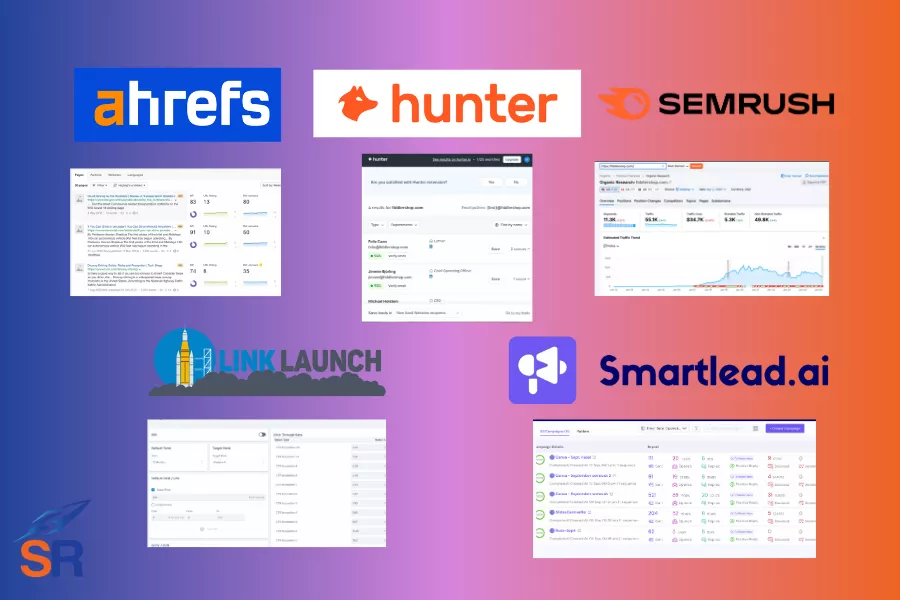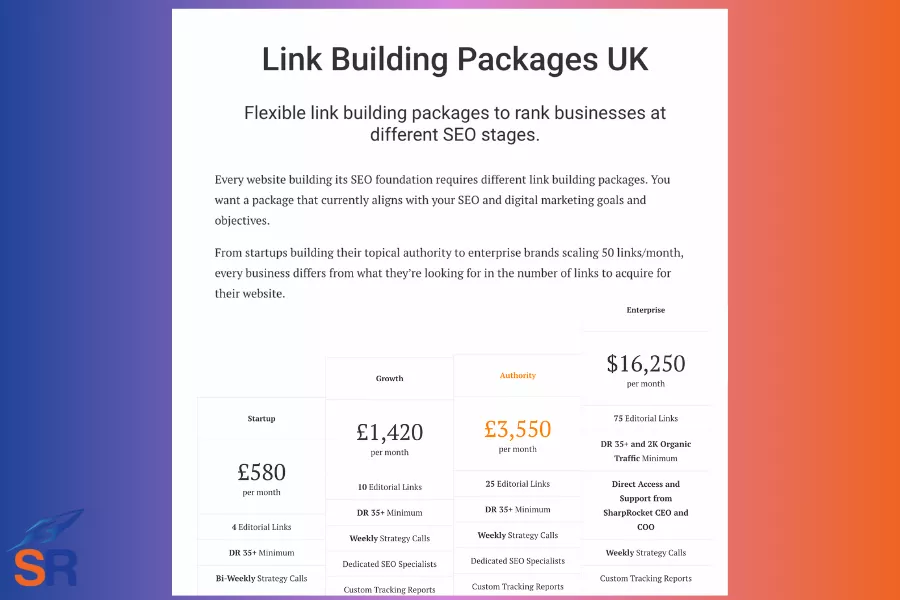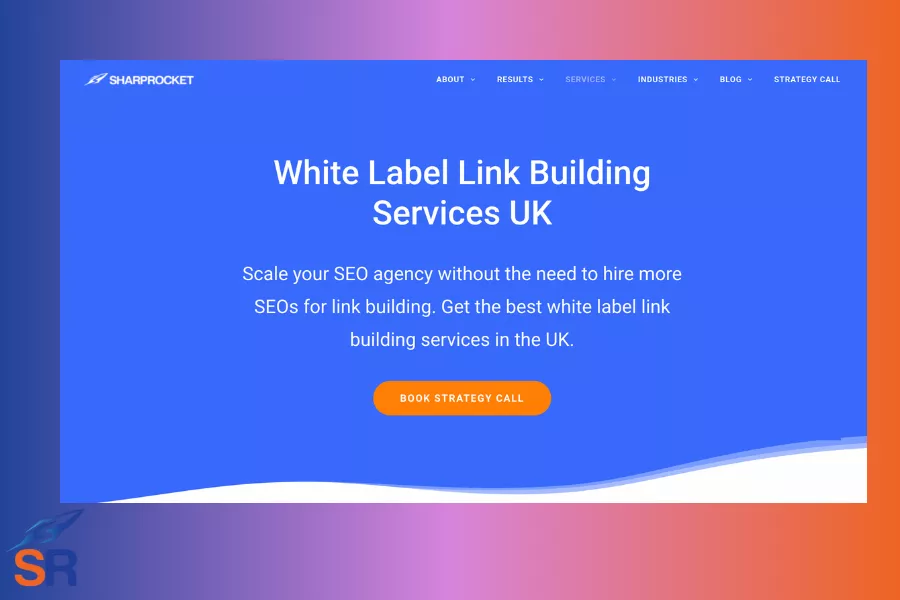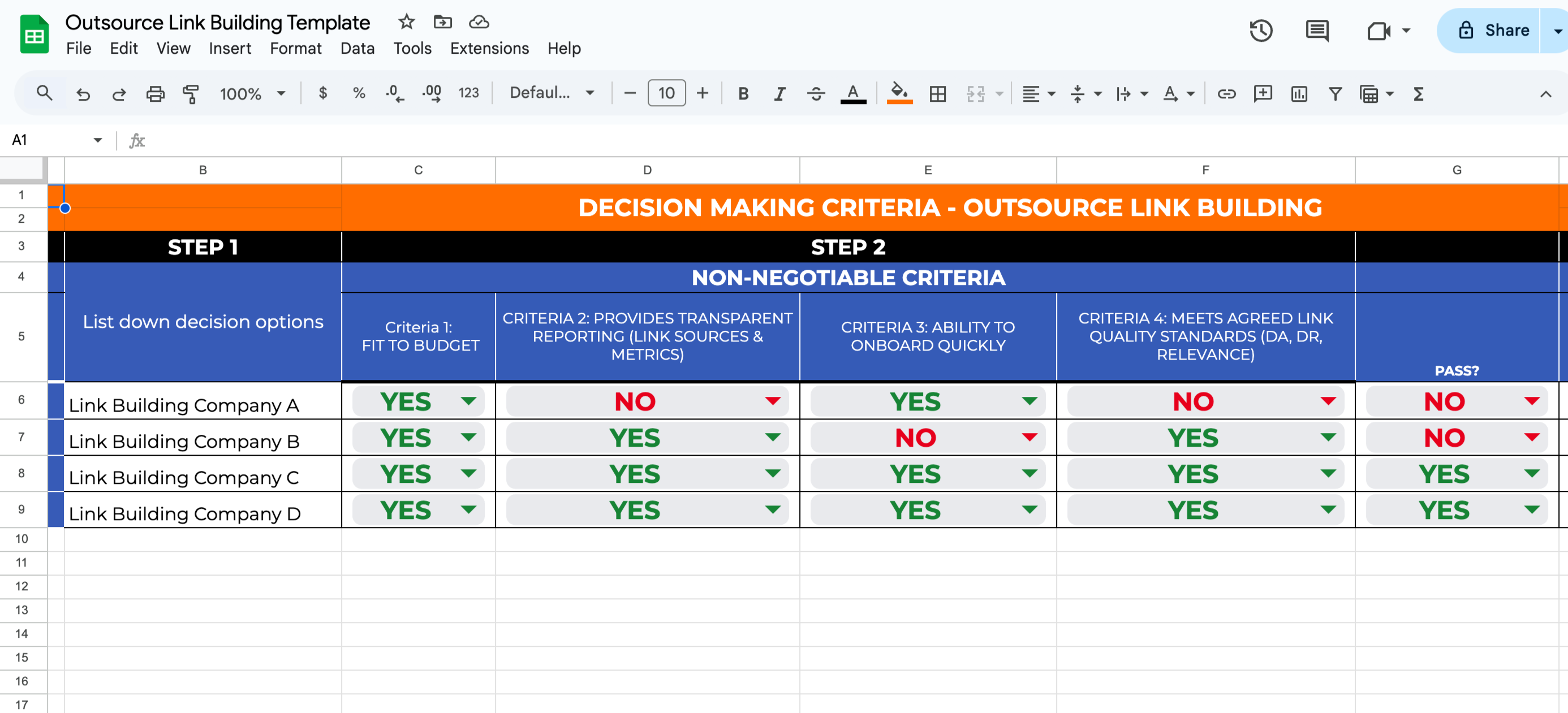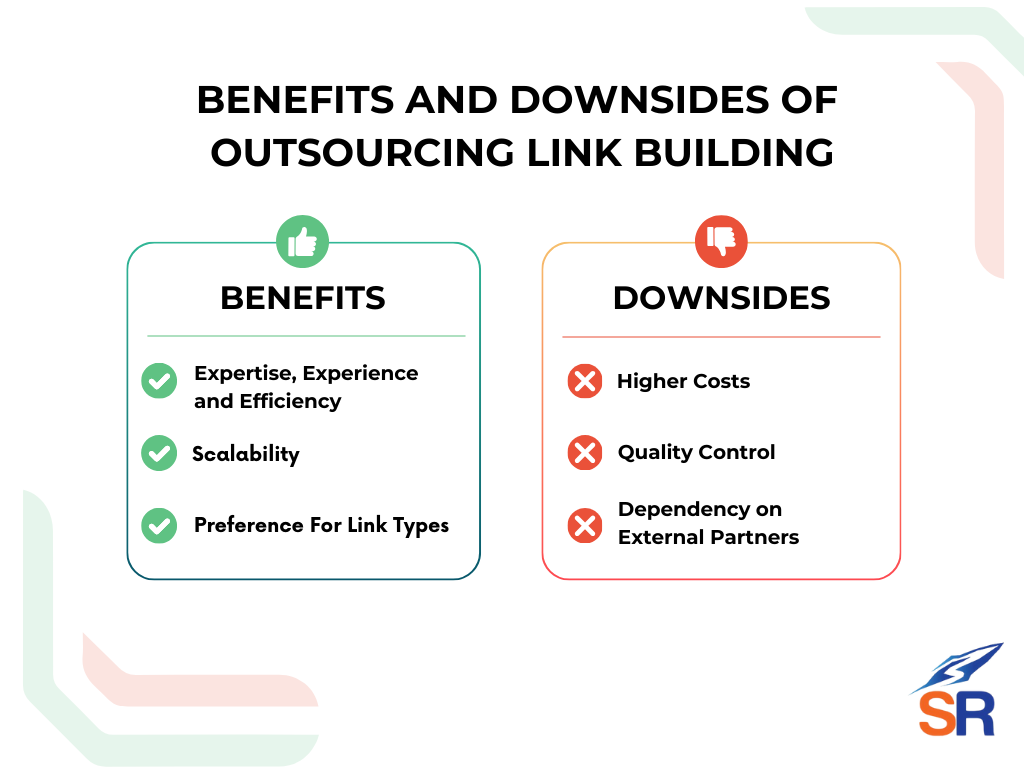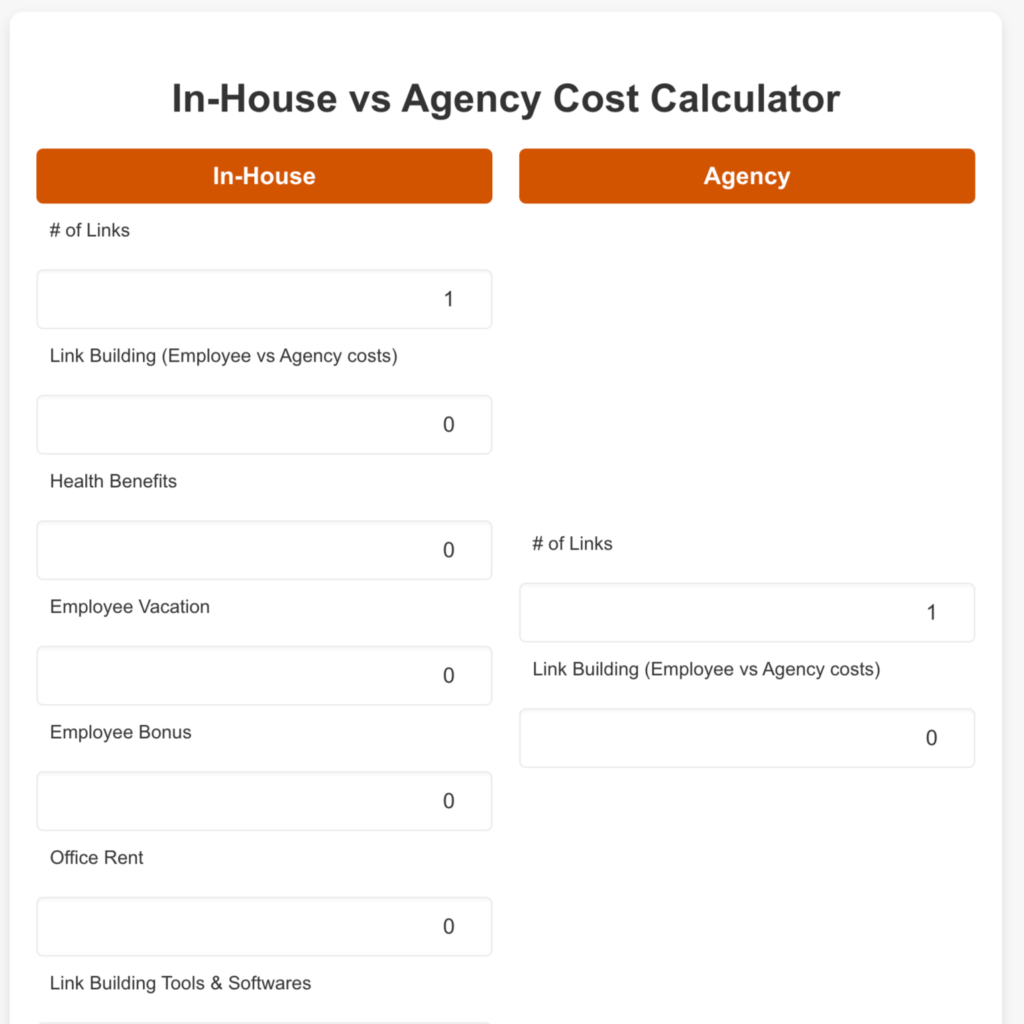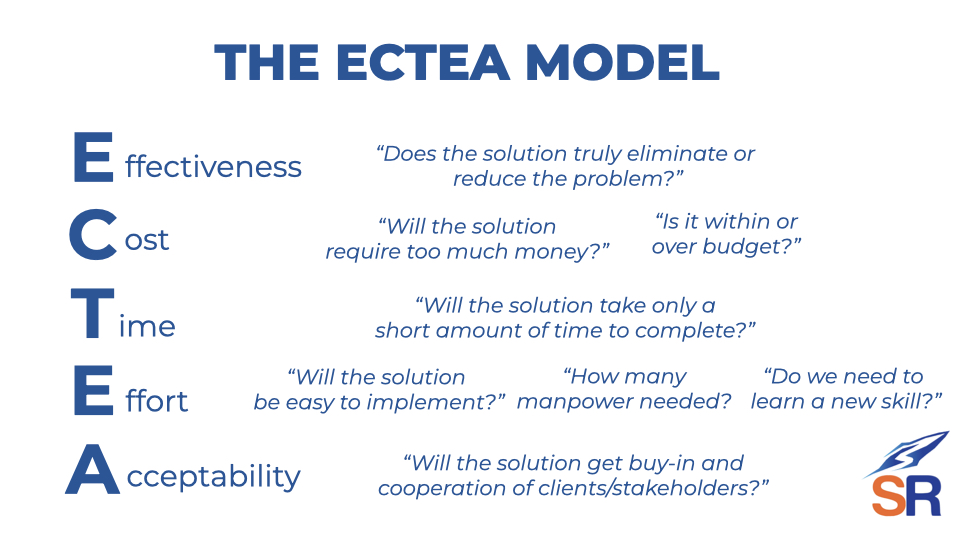Value-Driven Link Building Outreach [Unique Angles You Can Use]
Link building outreach comprises most of the work we do in our link building agency. We still find it effective in landing link opportunities that our clients' competitors can't easily replicate.
However, the resources, efforts, and time it takes for outreach accounts to grow and produce backlinks for clients are the bottleneck that most SEO specialists and agencies find challenging to overcome.
Links should be a byproduct of helping people achieve their goals: visibility, rankings, and promotion of their offers. It means helping people. The offer, approach, and objective may change, but the primary purpose of link building remains the same: adding value.
As the typical "guest post" pitch no longer works, it's time to find new angles and innovative ways to increase the value of your link building outreach campaigns.
Value-Driven Link Building Outreach Tips
In this guide, I'll show you unique outreach angles we've tested that are way more effective than requesting straight-up links.
1. Brevity in Initial Pitch
The first email in link building outreach sets the tone. One of the most effective tactics is keeping initial messages short. There are a few advantages to this.
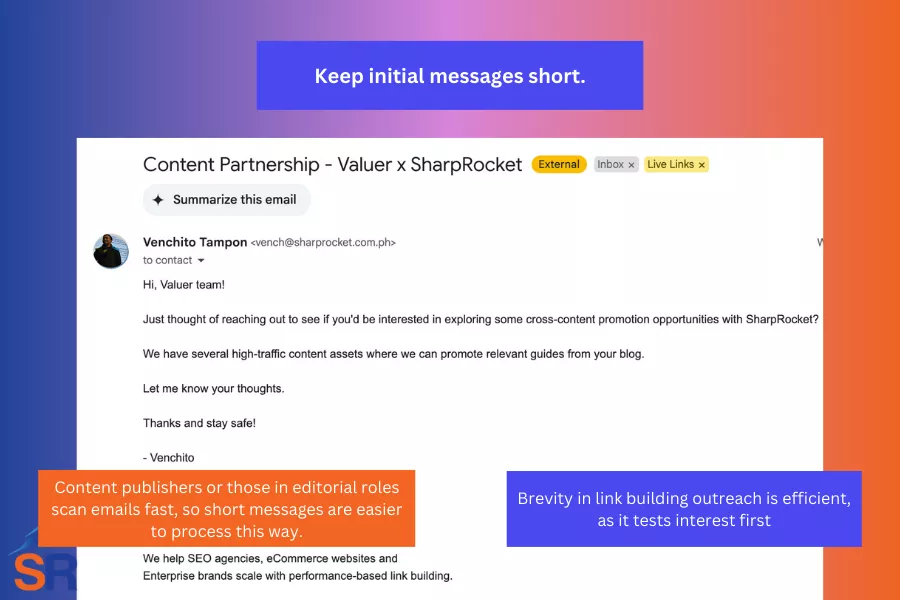
Long, overly detailed pitches create fiction and mental fatigue for busy publishers. Asking too much of the reader too early increases their resistance towards your pitch. When you open your pitch with a long email, you assume the recipient is willing to invest time in something they haven't asked for (reality: most won't).
Instead, keep your opening message tight and to the point.
Why brevity works in outreach:
- Leverage skimming: Content publishers or those in editorial roles scan emails fast, so short messages are easier to process this way.
- Increase response rate: A clear, focused ask is more likely to get a reply.
- Maximizes outreach time: You avoid spending too much effort on unresponsive contacts.
Brevity in link-building outreach is efficient, as it tests interest first. If they reply, you can then follow up with more detailed or tailored information.
In value-driven outreach, earning attention comes before earning a link.
2. Educate Publishers
Truly helpful content on the web educates. It is also why people link to pages in the first place: they find something useful that solves their problems or addresses their concerns.
In link building outreach, the same mindset can be applied to help people get more visibility.
One of the best types of linkers is legit brands and business owners. Google sees their websites as credible and more likely to be searched by its target users (branded and non-branded searches). As such, getting links from their business sites has higher link value compared to niche bloggers who don't have their built-in brand power.
In value-driven link outreach, education becomes your edge. Instead of requesting straight-up links, you can explain how reworking their current content that's been declining in traffic can be optimized for search and recover their traffic.
The plain reason is that most legit small brands aren't really knowledgeable about SEO. So sharing what you offer with them helps them gain more visibility and potential inquiries from ranking commercial keywords.
Use simple, non-technical explanations. Frame your "content improvements" angle as a favor to them, adding value to the conversations.
By actually giving them a reason to link, which is grounded in practical SEO benefit, you shift from a random stranger asking for a backlink to a helpful expert improving their content.
3. Content Refresh and Upgrade
Outreach is more effective when your offer improves what already exists.
Many websites have old blog posts, how-to guides, or listicles that still rank, but haven't been updated in months or years (which could position these pages higher in Google's SERPs once re-optimized). That's where content refresh outreach comes in.
Instead of pitching your link as just another resource, position it as a content upgrade (something that helps improve the page's quality, depth, and accuracy).
The outreach angle you're pursuing for this is the fresh update, that search engines reward and have been using as a ranking factor for years, to rank websites producing new, helpful content for their audience.
A few content refreshes or upgrades you can offer:
- New stats or data to replace outdated ones. It is also a good way to link to your larger data-driven content if it's thematically relevant.
- Missing section that covers a recent development. By getting immersed in the industry, you'll get updated with what's happening (more on this later).
- Visual (chart, infographic, flowchart) to enrich the reader's experience
- Deep guide that supports or extends an existing point.
Do the work for them. Rewrite the content with internal links to their site's other relevant pages (helping them get more visits on other content pieces).
» Want to take your outreach beyond templates? Explore advanced link building strategies in SEO that focus on relevance, value, and long-term results.
4. Be Updated with Industry Happenings
Immersion (as Jason Acidre coined it) is a strong factor differentiating your email outreach pitches from others.
Given that most SEO specialists and publishers will try to persuade blogs with generic topics. It would be an advantage if you knew the industry well and showed them what they're missing in the content. It adds more value to their audience and helps them differentiate their brand in the industry.
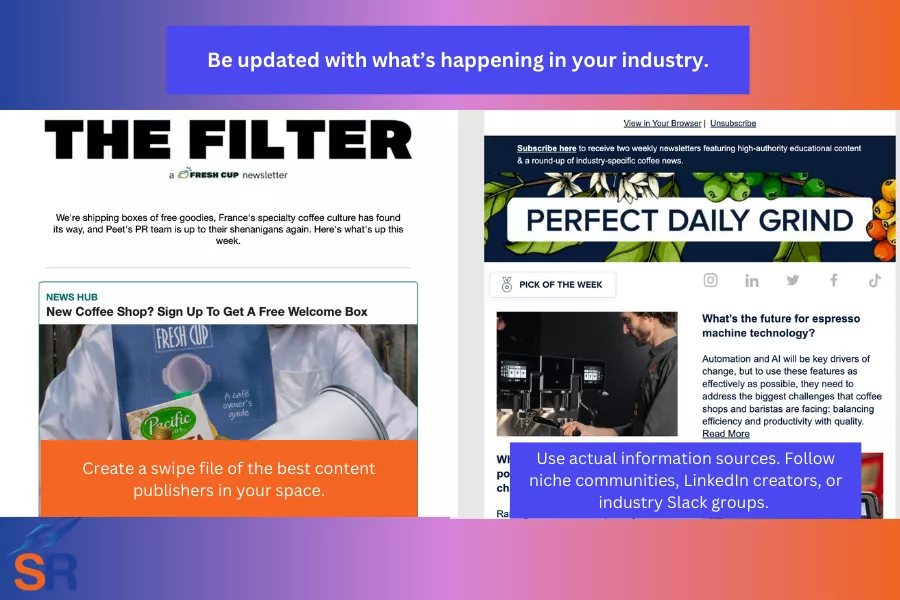
Create a swipe file of the best content publishers in your space. You can automate getting the latest trends, tips, and news by subscribing to their newsletters.
Here are a couple of ways to stay informed in your industry (even if you're not a subject matter expert):
- Be your own brand ambassador. Use your own experience if you're pitching for your brand. Get insights from customers' questions, sales feedback, and product updates (you know your business better than anyone else).
- Talk to people who know the space. If you're doing link building outreach for clients (or other teams), interview in-house experts, or sit in on internal training onboarding calls (just do whatever you can to get a real look at what's happening).
- Use actual information sources. Follow niche communities, LinkedIn creators, or industry Slack groups.
Once immersed in the industry, you can bring the knowledge into outreach.
The best thing about this approach is that when you reach out to publishers, most website owners won't spot content gaps unless they're fully involved in the topic.
This way, you can have so many outreach angles, including:
- Suggest updates to old posts that mention outdated tools or methods (share what tools have been highly reviewed in the industry).
- Recommended new angles based on emerging trends (rework their content)
- Offer data-backed resources based on recent studies.
Be like a consultant when pitching publishers, especially for new sites in the industry. You can help them by exploring new approaches to their content library.
5. Product Comparison Add-on
For eCommerce link building campaigns, this is one of the most high-impact link building outreach angles.
Given that getting links from posts that attract people who are actively searching, comparing, and making purchase decisions (i.e., Top X tools/products), especially those that rank well on Google's SERPs.
This outreach angle works because most round-up-style articles don't stay static. Publishers often (or want to) update them regularly, as they have the SEO benefit of driving consistent search traffic via rankings.
Help them with:
- Filling a gap in their current product listicle content.
- Adding new angles (e.g., best for beginners, best eco-friendly option)
- Reflects an emerging trend (e.g., AI features, sustainability, portability)
If your product has a unique POV, getting link placements from straight-up link requests would be easier. Provide more context on your product's unique value, which is suitable enough to be included in the list.
Create a list of product listicles. You can start by reverse engineering pages linked to your competitors' products (avoid the ones linked to big retailers or brands, as their websites naturally get links in the first place).
Find product list pages that are:
- Already ranking on page 1 or 2 for "best product" or "top product".
- Recently updated (check the date) or actively maintained (see "Last Updated").
- Missing your product or similar alternatives that your product improves on.
When doing link outreach using this angle, make your pitch stand out by:
- Positioning your product clearly (i.e. we're the best for XYZ feature").
- Frame it to benefit their content (i.e.," including us helps cover a broader segment of your readers").
- Make it easy for them to include your product (provide a quick smmary or suggested blurb they can copy and paste).
It's unlikely that your product beats others on everything. So, frame your angle to be best on a specific product feature or target customers. This would make specific relevance helpful to publishers trying to serve different audience segments.
» Looking for tools to streamline your outreach? Check out the best link building tools for SEO to scale and manage your campaigns efficiently.
6. Reverse Outreach
Outreach isn't enough to land more quality link placements. Especially if you're in a narrow niche, with limited publishers you can reach out to.
The best way is actually to create link opportunities yourself. That's where reverse outreach comes in.
Reverse outreach is a link building strategy where publishers initiate contact with you, not the other way around.
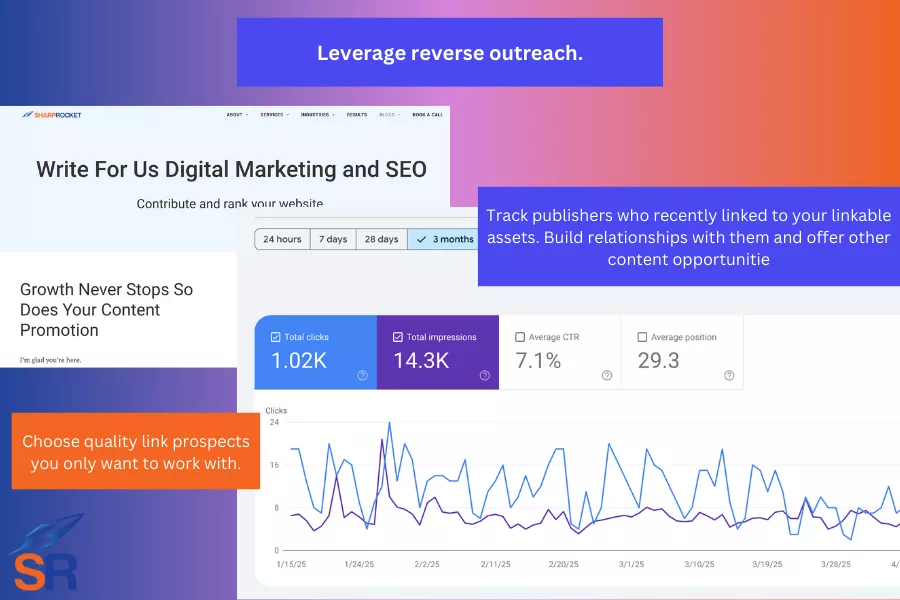
By ranking for keywords at the stage where they're writing their content or looking for references to add to their page, you would be found among the top-ranking pages in Google's SERPs.
The upside with reverse outreach is that you can control the value exchange, where you can:
- Choose quality link prospects you only want to work with.
- Have low resistance to link placement (leverage their desire for linking or content collaboration)
- Reduce outreach fatigue as you invest more in assets that do the prospecting for you.
- Scalable and sustainable (as it ranks and gets more visibility, the content can attract more passive link opportunities).
Create content that other people would cite as their resources, including:
- Original data or studies
- Free tools or templates
- In-depth evergreen guides
- "Write for us" or "Partner with us" pages
Another tip is to track publishers who recently linked to your linkable assets. Build relationships with them and offer other content opportunities, like collaborating on content, as both parties will certainly benefit from exposure.
» Need assets worth linking to? Learn how to create linkable assets that add real value and attract links naturally.
7. Stats-Driven Outreach
Data is one of the best reasons to update content, as it strengthens the page's credibility, makes it more current, and improves its chances of ranking higher in search results.
Stats add value to link building outreach, given that it or it has:
- Content freshness: Offering stats helps them refresh content without doing the research themselves.
- Fills missing context: You help them turn vague claims into precise, backed-up insights by inserting real numbers.
- Authoritativeness (E-E-A-T approach): When they cite credible sources or original data, it makes the publisher's page more authoritative.
- Do the work for them: Make it easy by writing the actual update or paragraph they can copy-paste with zero edits (offer that help upfront).
Don't have stats? You can curate stats using public government data and third-party data sources.
» Looking to get featured on real blogs? Check out our blogger outreach services that connect your brand with trusted publishers in your niche.
Link Metrics in SEO You Probably Don't Use Often
Vetting the right link opportunities and earning links from domains that truly matter starts with tracking the right link metrics. These metrics are actually what separate a successful campaign from a mediocre one.
If you purely rely on DR, which the majority of SEO agencies and in-house SEO teams use, you won't capture the full picture. A backlink from a high-DR site with zero traffic and irrelevant content often adds little value. Conversely, a link from a topically relevant website with focused content and real organic traffic, even if it has substantially lower DR, can move the needle in rankings and traffic.
Why Ahrefs’ DR Alone Is Not a Reliable Metric for Outreach?
In the early years of SEO, many SEO specialists (including me) relied on Google's PageRank. This algorithm, developed by Google's founders Larry Page and Sergey Brin, was one of the original algorithms used to rank web pages. It assigned a numerical value to each page based on the quantity and quality of backlinks, with the idea that a page is important if many other important pages link to it.
However, there was a time when PageRank stopped being publicly updated, so the SEO industry shifted to alternatives. Around 2010, Moz's Domain Authority (DA) became the popular benchmark. It provided a single number to estimate a site's authority, which was easy to report and track.
Today, the industry standard has shifted again. Ahrefs' Domain Rating (DR) is now the most commonly used metric by SEO specialists and trusted agencies. DR measures the strength of a site's backlink profile on a scale from 0 to 100, based on the quantity and quality of referring domains.
To balance it out, using Ahrefs' DR for outreach still has its advantages, and that's why most SEO agencies use it:
- It creates a fundamental level of domain reputation (e.g., aiming for DR25 or DR30+ links)
- It's visible at a glance with the Ahrefs toolbar (makes it easy to prospect for multiple link opportunities manually)
- It simplifies most performance tracking and team reporting (especially when working with in-house enterprise SEO teams).
Setting DR-based targets for link prospects is still the best approach. The only issue is relying on them alone while ignoring more accurate indicators of link value.
Here's why that's risky:
- DR reflects domain-wide strength, not page-level value.
- Google evaluates links based on context, relevance, and placement (factors not captured by DR alone)
- High-DR doesn't guarantee SEO impact (most of which, overused high-DR domains often have minimal effect).
We take metrics further as one of the best UK link building agencies.
When reviewing our list of link prospects, here are the link building tips and link metrics we consider (and you probably don't use often):
1. Check the Keywords They Get Traffic From
As you consider Ahrefs' DR of the website, review what keywords it ranks for. Use tools like Ahrefs or SEMRush to pull its top pages and top organic keywords. Both will show you whether the site attracts meaningful traffic from search terms relevant to your industry.
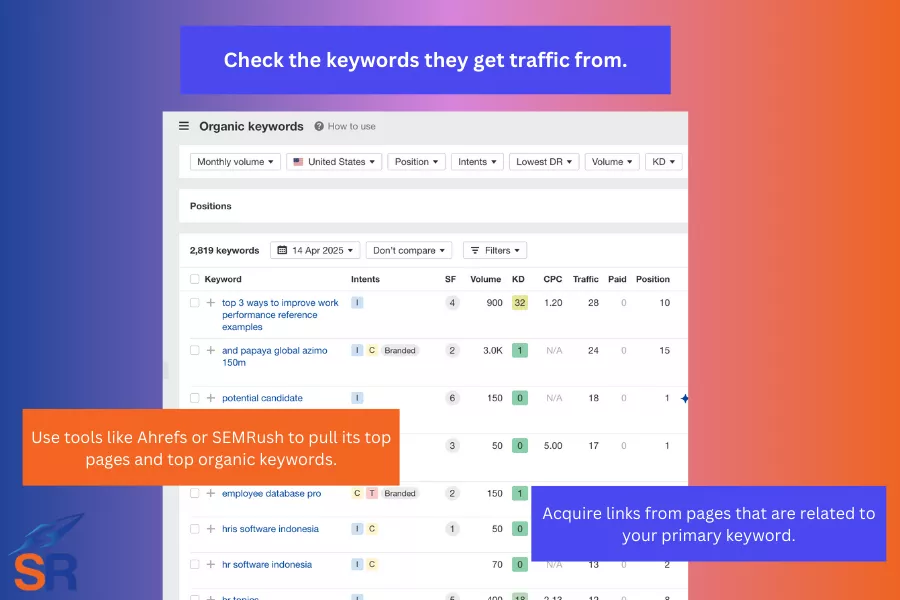
For example, if a marketing blog ranks for terms like "CRM tools for small business" or "email automation strategies, it's a strong signal that the site has topical authority (or at least has indexed pages with relevant topics).
However, if the top keywords are completely unrelated (or I may say, "spammy"), such as "online betting", or "essay writing services" (which by the way, I still see up to this date with some websites), that indicates the site is eiter overly commercialized, or part of a link scheme.
Checking keyword traffic can help you avoid websites that inflate traffic through unrelated or clickbait content (which is very easy to do). A site may appear active in terms of traffic and content publishing rate, but if its visibility is tied to irrelevant topics, the link carries little SEO value.
» Wondering how your competitors earn their links? Learn how to run an advanced competitor backlink analysis and find link opportunities they’re missing.
2. Contextual Relevance
Contextual relevance measures how well the linking page aligns with your topic, language, and intent content.
It's not enough for a site to have a high Ahrefs DR or strong traffic. If the content surrounding your link is off-topic, generic, or inconsistent with your industry, the link will have limited SEO value.
Here's what we look for in contextual relevance:
- Topical alignment: The linking page should cover a subject related to your content. For instance, if your page concerns project management tools, the link should come from a page discussing productivity, software, or workflow, not cooking tips or lifestyle hacks.
- Anchor text fit: The preferred anchor text should be natural and relevant to your target keyword (avoid forced placements or off-topic phrases).
- Surrounding content: The paragraph around the link should support and explain the linked page's topic.
- Minimal link dilution: Pages with fewer outbound links and a focused message provide stronger signals than link-heavy, general-purpose content.
The impact of contextually relevant links on your site compounds and benefits more than visibility. It helps Google better understand your website through contextual understanding of pages that link to your webpages.
» Want to go beyond basic outreach? Explore advanced link building strategies in SEO to earn high-quality links that actually move rankings.
3. Estimated Traffic of the Linking Page (URL-Level)
One of the main limitations of relying on Ahrefs' Domain Rating alone is that it scores the domain as a whole, but not the specific URL giving you the backlink. To better understand the link value (even by estimate), you need to check the estimated monthly traffic of the page that will link to you.
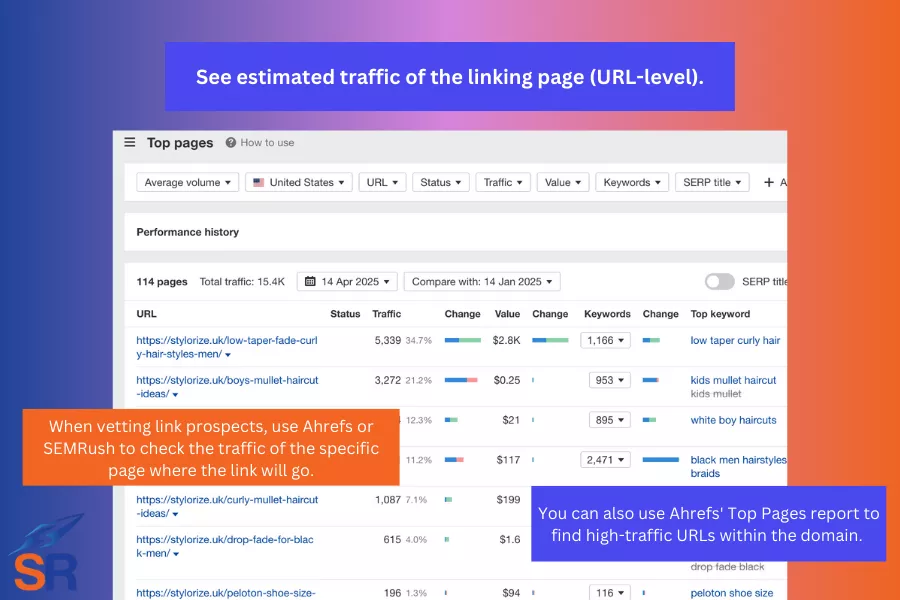
Here are a couple of benefits of using page-level traffic:
Identifies high-value pages on low-DR sites.
A low-DR website might publish one page that ranks exceptionally well, but is often dismissed by traditional link prospecting methods, given its average DR. Tracking URL-level traffic allows you to catch these hidden opportunities.
Rewards outreach to high-traffic pages.
A page-level traffic metric encourages outreaches to target a site's top-performing pages, which is a smarter move for SEO agencies to maximize the value from every link.
Compensates for recently launched or fast-growing sites
One of the overlooked parts of link prospecting is maximizing websites that are new or under-reviewed by Ahrefs, and have low DR, for that matter. But if its pages already rank and are driving organic traffic, those links are more likely to be valuable than DR suggests.
When vetting link prospects, use Ahrefs or SEMRush to check the traffic of the specific page where the link will go. You can also use Ahrefs' Top Pages report to find high-traffic URLs within the domain.
» Want to strengthen your existing backlinks? Explore modern approaches to tiered link building that boost link equity without using spammy tactics.
4. Aim to Get Dofollow Links (But Recognize Strategic Exceptions)
Even though Google has stated that nofollow links can be treated as hints (and are actual recommendations to the page/website), you can't rely on your link building campaigns on getting the majority to be no-follow links.
Especially if you're working for an SEO agency where clients are particular about the type of links you get, many SEO specialists don't count nofollow links as part of outreach KPIs. They only pay for do-follow links, as no-follow links are sometimes a by-product of an excellent digital PR campaign or other link building strategies.
Our best bet to be the default outreach strategy is prioritizing dofollow link placements.
The only exception is that many high-DR media outlets and authoritative news sites (DR70+) only offer nofollow links unless you pay steep fees. By also considering no-follow links, you get two key advantages:
- Builds relationships with top-tier publishers (intangible benefit, but can't easily measure) that can lead to future dofollow link placements, co-branded content, or digital PR features.
- Gain more branded exposure on high-traffic, trusted websites, where visibility can drive referral traffic, credibility, and long-term authority.
At best, aim for dofollow links by default, but don't ignore strategic nofollow link placements when they offer long-term brand and relationship value.
5. Link Placement Factors
As a link building consultant, I'm heavy on link placements, which is knowing where a link is actually placed on a page.
Given that Google gives more weight to links placed in the main content area, especially those that appear early in the content and are contextually relevant, it's one of the top link metrics every SEO specialist must consider.
Four important link placement factors we consider as a link building company:
- Position within the content: Links placed higher on the page or within the opening paragraphs tend to carry more weight—they are more likely to be crawled, seen, and clicked.
- Main body vs sidebar or footer: Links embedded in the main body text are far more valuable than those placed in sidebars, footers, author bios, or boilerplate sections.
- Surrounding content quality: The link should appear in a paragraph discussing the topic of your page (see our tip earlier on contextual relevance).
- Number of other outbound links: If the page has too many outbound links, the value is reduced to each one (fewer, more selective links indicate higher editorial standards).
Make it a standard practice to inspect where your link appears on the page. A higher likelihood of visibility helps attract more clicks and referral traffic to your destination page.
6. Outbound Link Profile Health
Outbound link profile health is the quality and relevance of the external links on a webpage, evaluating where a page is linking to, not just how many links it has.
Check where their external links go ("destination webpages").
Assess if the website links to quality, reputable sources or spammy, irrelevant, or suspicious domains (i.e., payday loans, crypto schemes, or thin-affiliated pages).
Outbound link profile health matters as it affects the credibility of your webpage. When your backlink sites include links to low-trust or manipulative websites, it sends signals that weaken your link's value (even if your own content on the page is strong and credible).
» Looking for tools to scale your outreach? See our list of the best link building tools for SEO that can help you build better links, faster.
7. Referring Domain Growth Trend
Check how fast or steady the linking website gains referring domains over time. If a site grows naturally, it suggests (probably seeing) that it's producing linkable assets and is seen as a credible source of information (its content assets are getting citations).
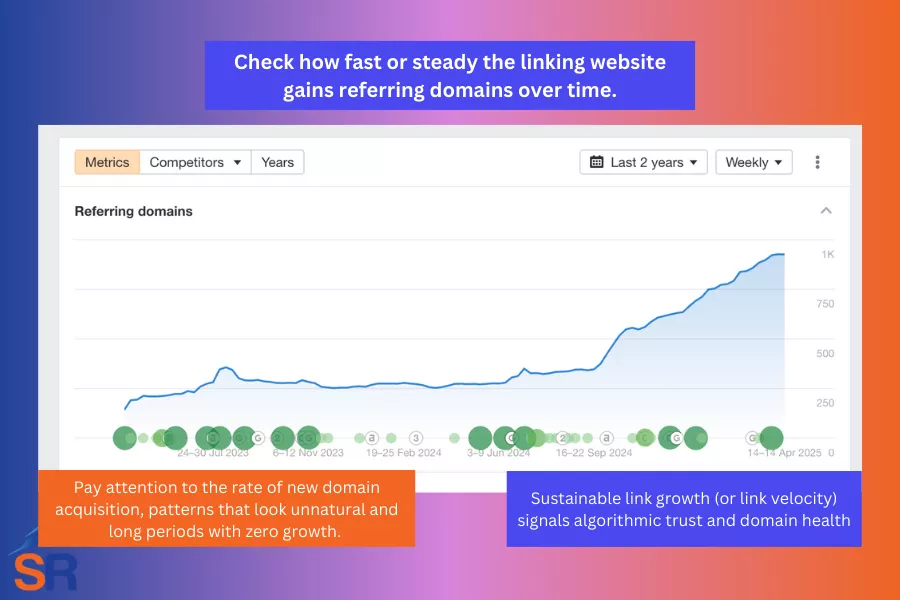
It's important to watch out for:
- Steady, upward trend: Indicates consistent publishing, link earning activity, and ongoing visibility in the niche.
- Sudden spike in referring domains Could be a sign of a robust digital PR campaign, aggressive link-building campaigns, or manipulative link-building tactics (see the site's backlink profile for deeper analysis).
- Flat or declining trend: Suggests the site may no longer be active in content publishing, lose its relevance in content, or not attract new organic links.
Use tools like Ahrefs' Referring Domains graph to review historical link data. Pay attention to the rate of new domain acquisition, patterns that look unnatural (i.e., 200+ new domains in one week, then none the next), and long periods with zero growth.
Sustainable link growth (or link velocity) signals algorithmic trust and domain health. Given that a website that earns organic links over time is being perceived as a highly credible source of information (vouched for by other niche publishers through their external linking efforts). While one website that grows too fast or stagnates may trigger a spam filter or lose ranking power.
» Looking for a trusted SEO partner to build high-quality links that pass the above link metrics? Check out our link building services designed to earn real, white-hat backlinks that drive results.
How to Create Conversion-Oriented Linkable Assets [+Examples]
Linkable assets no longer serve as pages "just to earn" links.
With our experience working with enterprise in-house SEO clients, we've seen the shift in the purpose of creating linkable assets. Beyond just attracting links to increase the site's authority (and improve rankings), they must also help move users through the customer journey and support the site's overall business goals.
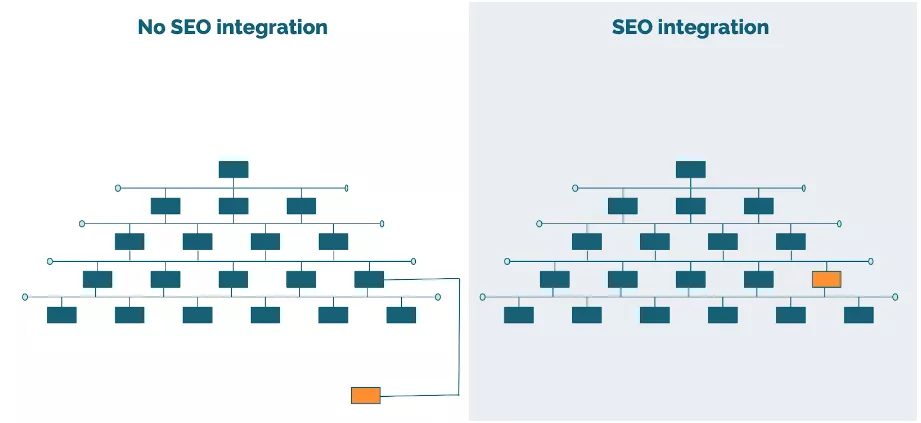
A Shift in Purpose
Before, linkable assets were built with one goal: to get links from other websites. SEO specialists were focused on creating content that would go viral, get picked up by journalists, or be featured in link roundups. Once the links were earned, the job was considered done.
The challenge is that many of these pages had no clear place on the website. They were often tucked away in corners where they wouldn't interfere with other content (which means they add little long-term value).
They were isolated. That approach no longer works.
Let me give you my new definition of linkable assets.
What are linkable assets?
Linkable assets are pieces of content created to earn backlinks while guiding users through key customer journey stages. They deliver practical value, such as templates, tools, data, checklists, or expert tips, and are built around specific user needs or early-stage problems. More than just informational, they’re structured to lead naturally toward a product, service, or next action.
Conversion-Oriented Linkable Assets
Conversion-oriented linkable assets target link acquisition efforts and assist conversions through the buyer journey.
Here are a couple of tactics you can test and implement for your brand:
1. Tie The Asset to a Problem Your Product Solves
For a linkable asset to drive traffic and conversions, it must address a problem that matters to your target audience and one that your product or service is built to solve.
When your content doesn't connect to the actual problems your audience faces (or the solutions you offer), it becomes isolated. It may earn a few links, but won't support your broader content strategy and brand authority.
Topping it off is the kind of traffic you want to attract from ranking with your linkable assets. It must be qualified traffic (people who are more likely to convert).
For instance, I've been heavily publishing franchising guides for my target audience - aspiring entrepreneurs- attracting passive links from other business bloggers and helping move visitors into the buyer journey (of inquiring about our franchise packages).
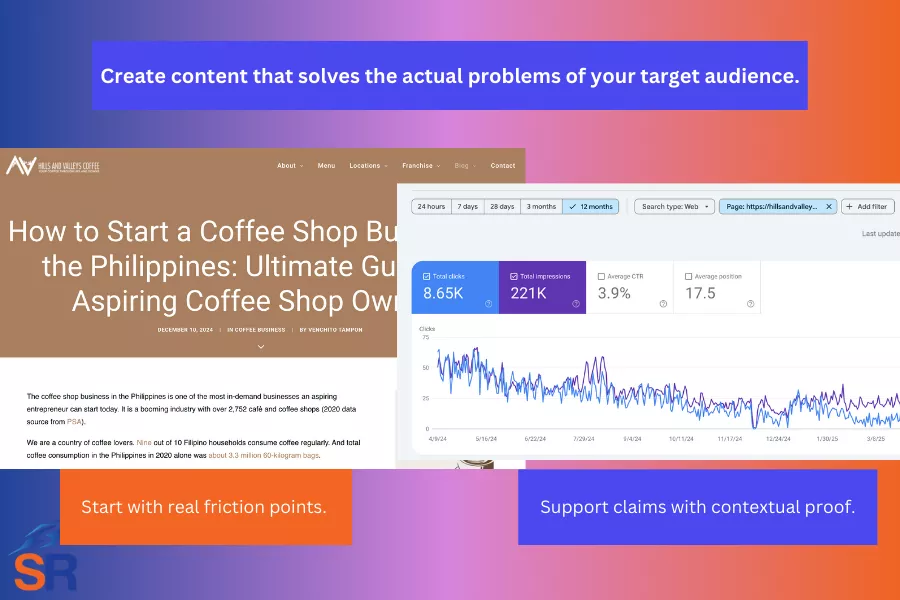
Start with real friction points.
Dig into support tickets, customer complaints, sales call transcripts, or onboarding surveys. These are all goldmines for uncovering the exact wording and issues your audience is already struggling with.
Solve one problem, not a category.
One citable element topic you can add to your landing page is content pieces that target one sharp pain point. These pieces are easier to share and connect to a product feature.
For example, instead of tackling "Remote Work Challenges", you can zero in on one like "missed deadlines due to unclear ownership", a quick section guide on "Why project deadlines slip in remote teams?").
Support claims with contextual proof.
Proofs are better than promises. Instead of just listing stats, show how the problem affects outcomes. Combine data with before-and-after scenarios, customer quotes, or use case breakdowns. One tip here is to use visuals like “problem → solution” timelines or annotated screenshots that can make technical solutions easier to grasp.
Optimize for internal link flow.
Do smart internal linking to pass link equity to your site's important pages. Link to supporting blog posts for depth (or next steps of resources) and link in from related product or resource pages.
2. Publish First-Party Data or Insights
Linkable assets that include first-party data stand out. You collect these insights directly from your audience, customers, or internal stakeholders. Given they're original and reliable, they can earn links that are hard to replicate by your competitors.
Most websites repeat the same statistics from popular blogs and reports, but when your asset shares data no one else has, you position your brand as a source instead of a mere distributor of information. This helps you draw attention and potential links from journalists writing industry stories, bloggers looking for original stats, and educators referencing niche topics.
How first-party data attracts links:
- Become the original source. Publishing unique data makes your site the primary reference point.
- Get cited in link roundups and other industry reports. Writers constantly search for new stats for listicles, "top trends," or "industry reports" (your original data gives them exactly what they need).
- Attract organic shares without manual outreach. When your insights are genuinely helpful, surprising, or time-sensitive, they provide a reason for people to share them naturally.
- Builds initial trust that earns links—the idea of having "statistics" itself initiates trust, as it is not something you can easily create without putting in enough work.
- Earn natural links from your brand's network. Customers, partners, and vendors may use your data in their business presentations, decks, and offline resources.
- Automate link building via ranking for stat-based search queries. Make sure you properly optimize your content for target stat keywords.
3. Identify the Step Before Your Solution
While the first tip of aligning your asset with a problem your product directly solves, another powerful approach is to go one step earlier:
Create content around the steps before someone needs your product.
These are research-driven, early-stage actions before they're ready to buy, subscribe, or engage.
Meeting them at the stage makes your content more than link-worthy. It becomes a bridge that connects their current challenge to your solution.
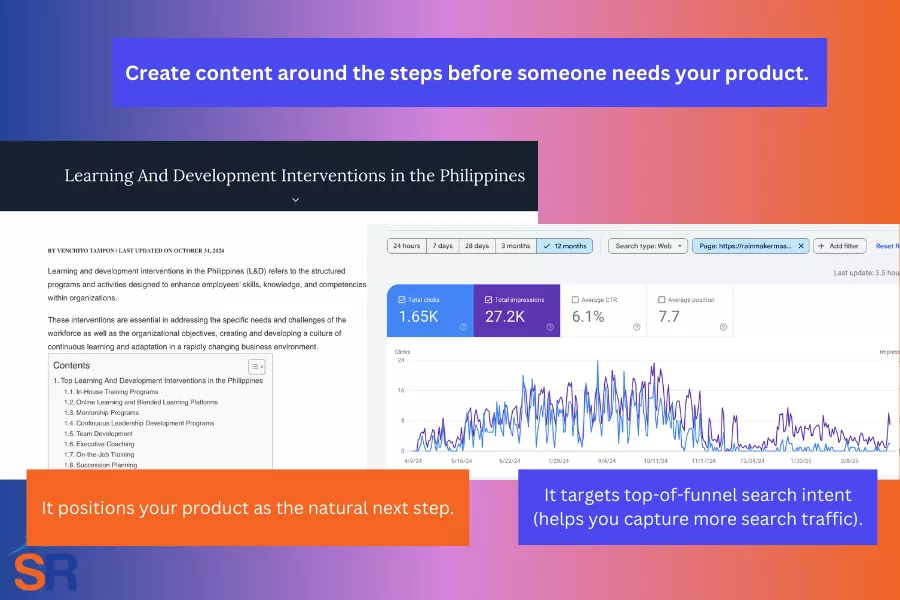
Why "before-the-solution" linkable assets work:
- It targets top-of-funnel search intent (helps you capture more search traffic).
- It attracts backlinks from educational and industry resources in your space.
- It positions your product as the natural next step
- It builds trust by adding value and genuinely helping people before selling
In creating linkable assets based on the steps before your solution, you need to understand your audience's decision-making process, not just what they need from you, but what they must go through before they realize your product is the answer.
Start by asking these questions.
1. What does someone need to understand, research, or prepare before they can use our product?
Think about the learning curve or awareness stage that your customers go through.
- Are they researching how to fix a specific issue?
- Are they comparing methods, tools, or strategies?
- Do they need to build a case internally before buying?
For instance, if you're doing a cybersecurity SEO campaign, you might identify that buyers first research "how to perform a security audit?" before looking for software, so a great linkable asset: "Step-by-Step Guide to Running Your First Cybersecurity Audit".
2. What issue or blocker do they typically face before they convert?
Identify the friction point that causes hesitation or slows the path to purchase:
- Are they unsure of what solution fits their situation?
- Are they missing resources, clarity, or approval?
- Do they fear making the wrong choice?
A good example of this is analytic tools (link building for SaaS), where you might discover potential buyers struggling to understand what metrics they actually need to track (creating a content asset on “10 Key Marketing Metrics Every Growing Business Should Watch and Why They Matter").
3. What content would help them at that point, and naturally lead to our solution?
Create content that meets them at that point with practical help. Shift from analyzing user intent to building a resource that solves their immediate need, without pushing your product too hard.
You earn links this way and create a moment of clarity where the reader thinks it is exactly what they need and sees if your website (brand) offers any solution.
4. Offer Zero-Friction Tools or Templates
Getting easy and early access to tools or templates people can use without barriers, signups, or complex instructions makes an asset linkable.
These linkable assets work because they deliver instant value, resulting in a resource that solves a specific, clearly defined problem.
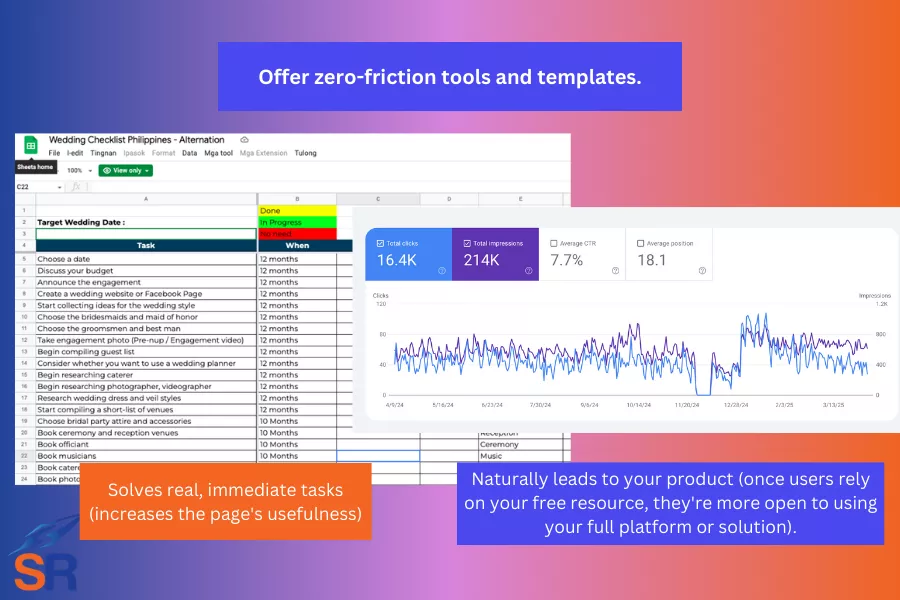
Why zero-friction tools are solid linkable assets:
- Solves real, immediate tasks (increases the page's usefulness)
- Easy to share or embed (content creators and publishers love linking to practical tools)
- Naturally leads to your product (once users rely on your free resource, they're more open to using your full platform or solution).
Here are a couple of formats of zero-friction tools or templates:
- Editable templates - Google Sheets, Notion, or Canva files that users can customize (e.g., 30-Day Social Media Planner Template)
- Checklists and worksheets - step-by-step guides, printable PDFs, or fillable forms (e.g., Product Launch Readiness Checklist)
- Mini tools and calculators - quick-use tools that help estimate or compare something (e.g., Email List Cost Calculator)
- Scripts and prompts - ready-to-use messages for outreach, sales, or communication (e.g., 5 Sales Email Templates That Get Replies)
- One pager and visual frameworks - simple visuals like flowcharts or decision-trees (e.g. Marketing Funnel Fix-it Flowchart)
You can optimize pages to include these zero-friction tools and rank for problem-solving queries, increasing your chances of earning more passive links through high rankings.
5. Apply Unique Expertise to Sales Pages
Use your team's specialized knowledge (research, process insights, etc.) directly on your product or sales pages. This will transform your standard transactional content into link-worthy referential material that adds value beyond the sale (and publishers will link to it, even if it is commercial in nature).
What to include based on your expertise:
- Proprietary scoring or rating systems
- Common mistakes your product helps prevent
- Internal benchmarks or quality thresholds
- Use-case scenarios from support or onboarding logs
- In-house tips, techniques, or shortcuts
- Chronology or iteration history of product development
- Decision-making frameworks used by your team
- Internal testing protocols or standards
- Product-specific troubleshooting insights
- Expert-recommended usage routines or best practices
One good example, if you're doing eCommerce SEO, is publishing a best practice angle:
“Our in-house ergonomics team recommends adjusting the chair height so your elbows form a 90-degree angle while typing. This position reduces shoulder tension and improves long-term posture. That’s why our chair includes a guided adjustment checklist under the seat.”
This example draws from expert-recommended usage routines, which address a common user challenge - a value-add to your product page, reinforcing your brand authority.
Need help with your link building campaigns? See our link building services and let's have a free strategy call.
Modern-Day Tiered Link Building: Link Stacking (and Smarter Alternatives)
Traditional tiered link building no longer works. Creating backlinks to levels of linking pages to your website was once a way to improve site rankings through layered authority.
In the past, SEOs built links not just to their website but also to the pages that linked to them, referring to Tier 2 and Tier 3 links, in which the goal was to increase the power of Tier 1 backlinks and pass that strength down the chain.
How search engines like Google perceive and recognize backlinks today has evolved.
Why Traditional Tiered Link Building Doesn't Work?
While it's a systematic approach to link building, traditional tiered link building no longer works for many reasons.
1. Link Decay and 404 Errors Break the Chain
Backlinks are not permanent, as the web is constantly changing. Pages get updated, deleted, or moved, particularly during this time when the rate of content publishing has accelerated. This means that your Tier 1 backlinks (the ones linking directly to your site) can eventually disappear. When that happens, the entire link chain breaks.
If you've invested time or money building Tier 2 links to boost a Tier 1 page, and that Tier 1 page goes offline (returns a 404 error or gets redirected), all the value from those Tier 2 links is lost. Google can't crawl through a broken link to reach your site. As a result, the link equity stops flowing.
The challenge with this scenario is that it becomes worse over time. As websites restructure or remove content, the likelihood of link decay increases. Even high-authority sites can remove pages without notice. So, if your entire strategy depends on supporting a Tier 1 page that's no longer active, you risk highly of your backlink profile.
2. Direct Links Pass More Value
In today's SEO landscape, Google gives more weight to backlinks that point directly to your website, especially when those links come from authoritative, relevant sources.
When a site links to your page, Google views that link as a clear signal of trust, relevance, and endorsement. It's direct, easy to crawl, and tied to content that users can immediately access. These links carry more ranking power and help improve your site's visibility in a more predictable way.
Conversely, indirect links (those that are buried in a tiered structure (Tier 2 to Tier 1 to your site), lose their strength as they pass through multiple layers. Every jump from one page to another dilutes the potential link equity. If the Tier 1 page isn't indexed, lacks authority, or is poorly optimized, even a strong Tier 2 link won't help you. The benefit of layered link building stops before it reaches you.
A direct backlink embedded in meaningful content will outperform a tiered link structure built on low-value pages.
3. Contextual Relevance Matters More Than Structure
Google focuses heavily on contextual relevance. With hundreds of backlinks we build every single day with our link building agency, we've observed quite well how powerful relevant backlinks are to the website.
A backlink placed within content that matches your topics or industry will pass more value than one that's technical "part of a tiered system."
Google is better at understanding what content is about, so it expects backlinks to come from content that's thematically aligned with the target page. For instance, if your site is about dental software, a link from a healthcare IT blog will be more valuable than one from a fitness receipt site (even if both pages technically point to your content).
Traditional tiered link building fails here because it often prioritizes link quantity over contextual quality. The end result is a chain of weak signals instead of a strong, relevant recommendation.
4. Harder to Track ROI and Value
When the strategy involves creating multiple layers of backlinks (Tier 2 to Tier 1 to your site), it becomes challenging to identify which links are actually making a difference.
Let's say you build 10 tier 2 links to a blog post (Tier 1) that links to your site. Your rankings slightly improved, but where did the lift come from? Was it the Tier 1 link itself? Did one of the Tier 2 links influence it? Was it due to another backlink if Google found it elsewhere? There are no clear, direct signals to measure.
The more layers involved, the harder it is to isolate what's working, making it extremely difficult to assess the return on investment on link building.
You need to know where your gains are coming from so you can focus on what works and eliminate what doesn't. Tiered link-building strategies blur the bigger picture and create too many unknowns.
Link Stacking: Modern-Day Tiered Link Building (and Smarter Alternatives)
While traditional tiered link building is outdated, the core idea of strengthening your most valuable backlinks is essential for link development; we call it "link stacking".
What is Link Stacking?
Link stacking is the strategic practice of amplifying the value of your strongest backlinks and replicating them more often by increasing their visibility, authority, and contextual relevance, without relying too much on artificial link structures.
Link Stacking Strategies That Work
Here are proven link-stacking strategies that work in 2025.
1. Identify and Replicate High-Impact Backlinks
The best way to start is to know which backlinks are worth amplifying and replicating. Run a backlink audit using link intelligence tools like Ahrefs, SEMRush, and MajesticSEO (see our hand-picked link building tools for SEO).
See backlinks from authority domains, driving real referral traffic and pointing to the most important pages (or your blog content, acquiring search traffic via ranking for informational queries).
Replicate these high-impact backlinks that have been driving significant value to your site (as doing more of them can help improve more of the metrics you're looking at—referral traffic, rankings, brand visibility, etc.).
Study the content that earned the highest-impact links. Is it a how-to guide, a case study, a list of tools, a data-driven piece of content, or a citable element on a landing page?
Once you've identified the format and topic that attracted backlinks, create more content using the same structure and angle but more focused on new subtopics, updated trends, or related industry keywords.
For instance, if a list of "Top CRM Tools for 2025" earned strong backlinks, follow up with "Best CRM Tools for Startups"—these are pieces of content tailored to your target persona and aligned with the user's buyer journey.
2. Do Smart Internal Linking
The authority on the page where you get the most links doesn't have to stay confined to that page. You can use smart internal linking to direct some of that value to other important pages on your site.
Revisit your blog posts with the highest number of referring domains, resource pages with backlinks from authority sites, and landing pages that earned natural citations or mentions.
Add contextual internal links to the most important product/service pages, newer blog posts that need ranking support, and categories (or hub pages) that build topical depth.
You can add sections such as "related sources" at the bottom, embedded videos or downloadable tools, and internal navigation to deeper subtopics. Doing so increases the number of pages per visit, improves your site's crawlability, and efficiently spreads SEO value across your content ecosystem.
3. Distribute Content Targeting Keyword Variations of Your Core Topic
One way to scale your link stacking strategy is to create and distribute content that targets keyword variations related to your primary topics. Instead of repeating the same angle or keyword focus, this approach allows you to cover more ground and reinforce your site's authority on a subject.
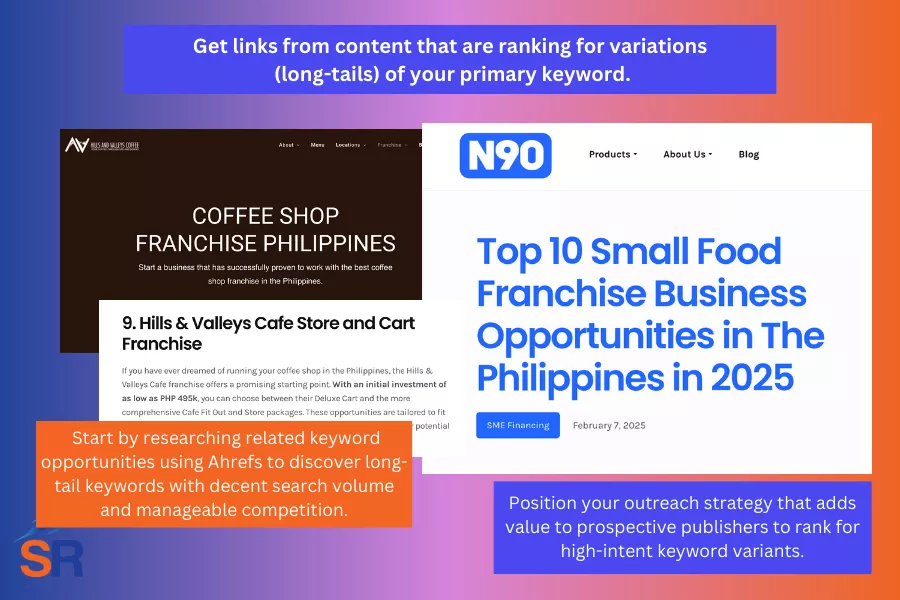
Google rewards topical depth, so as you consistently publish and earn links for content around a central theme, you start building your site's topical authority (off-page).
Identify keyword variations with potential. Start by researching related keyword opportunities using Ahrefs or SEMRush to discover:
- Long-tail keywords tied to your core topic
- Variations with decent search volume and manageable competition
- Subtopics that address specific segments, pain points, or use cases
For instance, if your primary keyword is "project management tools," variations might include "project management tools for remote teams" or "free tools for agile project workflows."
Do value-driven outreach.
Instead of simply soliciting backlinks, take a smarter route of offering to publish content on their site that targets keyword variations of your shared niche. The upside is that it's geared towards the value it could bring to the table, benefiting your target publisher.
Mid-level publishers need more search traffic and quality content that ranks for new long-tail keywords optimized for underserved but high-potential queries.
You provide all that by offering content that targets specific keyword variations, ones with clear search intent and volume that may not be covered yet.
By positioning your outreach strategy that adds value to prospective publishers to rank for high-intent keyword variants, you increase the likelihood of higher responses and link placements that directly improve your site's ability to rank for your primary keyword (as distributed content is topically relevant to what you're trying to rank for).
4. Turn High-Performing Content Into Multi-Format Linkable Assets
When a piece of content earns strong backlinks, it clearly signals that it holds value for both users and publishers. You can multiply its link potential by turning it into various formats that attract different types of audiences, learners, and content creators.
Repurposing content pieces is a strategic link-stacking move to get more backlinks from more platforms using content that's already proven to work.
A few formats you can consider:
- Infographics - visual summaries of stats or steps from your post
- PDF guide or downloadable - useful for resource pages or B2B listicles
- Slide decks - add more visual depth
- Short-form video - condense the content into explainer or how-to videos (which you can also upload to YouTube and earn organic social traffic).
By turning high-performing content into multi-format assets, you also increase the surface area of discovery through LLM's AI models. The more accessible and multi-platform your content is, the higher the chance it gets referenced in AI-generated answers, included in citation stacks from AI tools, and more often suggested by Google's AI Overviews.
Schedule a free strategy call if you're looking for the best link building agency in the UK.
Best Link Building Tools For SEO [2025 Honest Review]
As considered to be the UK's best link building agency, the most common question we've been asked is what are the best link building tools for SEO we use to scale our campaigns.
In this 2025 review, we're sharing our full list.
These are the tools we rely on daily legwork to find quality link prospects, manage outreach, track results, test new link building strategies, and improve results across our clients' link building campaigns.
For a quick look, here's our top pick for each key task:
Best Tool for Competitor Link Research, BackLink Analysis, and Link Prospecting: Ahrefs
Ahrefs is our top choice for getting deep insights into your competitors' backlinks. With their tool features like Site Explorer, Link Intersect, and Content Explorer, you can find highly relevant, authoritative sites linking to others in your industry and quickly build a list of targets. It's a good starting point for high-impact prospecting and scalable link building campaigns.
Best Tool for Finding Emails: Hunter.io
Once you have a solid list of link targets, Hunter.io helps you find accurate email addresses linked to each domain. Whether you're searching by domain or by name and company, Hunter makes email discovery quick and reliable. It also verifies email deliverability to reduce bounce rates in email outreach campaigns.
Best Tool for Email Outreach: SmartLead
SmartLead lets you send personalized cold emails at scale. With unlimited inbox rotation and a unified inbox for all replies, it keeps your outreach organized and effective. It's built for link building teams that care about deliverability, automation, and landing high-quality link placements.
7 Best Link Building Tools For SEO (Our Top Picks)
Below are some of the best link building tools for SEO that we personally hand-picked:
1. Ahrefs (starts at $129/mo)
Ahrefs is our top-picked link building tool as an agency, considering it is highly useful for a wide range of tasks in link building.
It offers one of the industry's largest and most updated backlink databases. It assists in most of the tedious tasks of prospecting and analyzing the types of backlinks of competitors and other relevant sites.
Let me walk you through some of the tasks we use it for:
Competitor Backlink Research
Feature: Site Explorer
One of the best ways to start your link building campaign is to look at where your competitors have acquired their backlinks, especially those currently ranking for your target keywords. It shows you where these links come from and helps you generate ideas on what specific link building strategies have proven to work and which ones you can replicate for your campaign.
Ahres helps you conduct thorough competitor backlink research. The Site Explorer feature shows you all the backlinks pointing to any domain, URL, or subdomain. Whether you want to reverse the entire domain's links data or a specific page/content, you'll have it assembled with Site Explorer.
The best part of Ahrefs is its ability to filter backlinks based on your desired link metrics. And if you're a UK newbie link builder, you can choose the "Best Filters" so it would do the filtering for you on websites that are do-follow, in-content, DR30+, 500+ organic traffic, and less than 200 external links on a page - it's the default setting, but you can customize it to fit your needs.
For any link building campaigns we start, I filter sites based on DR and traffic alone (DR30+ and organic traffic of 500+). With that quick analysis, I can decide if exporting the list, analyzing it further, and reaching out to the same link prospects is worthwhile.
I dig deeper into some links for advanced link building strategies by filtering them based on link type, destination page, or number of referring domains. For instance, if I want to see listicles (for SaaS link building), I'll filter links from external links (7 to 30).
Another example is filtering sites to homepage links to find branded mentions (with links) or valuable links through digital PR campaigns (which mostly link to brands' homepages).
Discover Link-Worthy Content Topics
Feature: Content Explorer
Creating linkable assets starts with assessing which topics are link-worthy. This means that when you start publishing and do a little bit of outreach, you'll have chances of earning backlinks from target publishers.
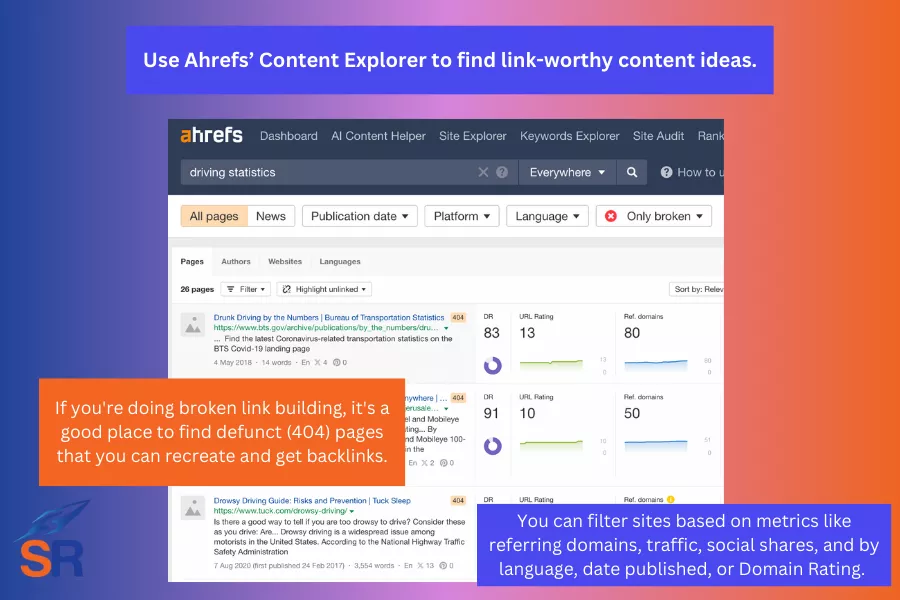
With Ahrefs' Content Explorer, you can search for any keyword and see pages that earn the most links. You can filter sites based on metrics like referring domains, traffic, social shares, and by language, date published, or Domain Rating.
For example, if you want to search for industry-related topics, you can search for "statistics" and "topic" and filter them by referring to domains (>50), English language, and publication dates from the past year.
If you're doing broken link building, it's a good place to find defunct (404) pages that you can recreate and get backlinks by either reaching out to publishers who linked to the dead page or finding new links pages that are topically relevant to your republished content.
Find Link Prospects That Haven't Linked To You
Feature: Link Intersect
When Ahrefs launched this feature years ago, I was one of the first SEO specialists to try it, and I knew it would be one of the best features of Ahrefs. Rightfully, it did so, as Link Intersect allows you to compare your site to competitors and shows domains that link to them but not to you. Other SEO tools haven't replicated this invaluable feature at the time of this writing.
This task alone, doing link intersect, cuts prospecting time in half (even 70%) by pointing you to sites that are clearly open to linking to similar content or businesses. If pages link to 2 to 3 of your highly relevant competitors, they would also link to you, assuming you have a similar or better value proposition in your email outreach.
Reclaim Broken Links and Lost Opportunities
Feature: Broken Link Checker
Link decay happens when one of your links is broken. Either the hosted page removes your link, or it is removed by error or by purpose. This is often the case with many of the websites that are earning links.
Besides actively pursuing links every month, it's a good practice to look at your site's broken links and see which ones you can recover. Given that you've tried to get those broken links in the past, it would be worthwhile to retrieve them with a quick nudge in your emails.
Track Your Backlinks
Feature: Backlink Alerts
There are a handful of free alert tools, like Google Alerts, but if you purchase Ahrefs, take advantage of its Alerts feature.
You can set up email alerts for new or lost backlinks to any domain. Ahrefs notifies you as links appear or disappear, keeping your campaigns updated in real-time. So, you can either follow up with lost backlinks to reclaim them (as I mentioned earlier) or replicate the strategy that allows you to earn new passive links (without doing any manual outreach).
SharpRocket's Take on Ahrefs:
As a link building agency in the industry for over a decade, we've used Ahrefs for every possible task related to link acquisition. It is a powerhouse SEO suite as it also assists in SEO audits and keyword research, making it cost-efficient for agencies to have it in their SEO arsenal.
The only caveat is its starting price. For the UK's newbie SEO professionals or starting SEO agencies, $127/mo may be too steep, especially if you're still building your client base or working with limited budgets.
It's smart to start with lighter tools or use Google extensively for link prospecting or other free link building tools that cover the basics of using Ahrefs. Once you begin scaling and need deeper backlink insights or faster and more streamlined processes, investing in Ahrefs becomes a more justifiable and high-impact investment.
2. Hunter.io (Free + starts at $34/mo)
Discovering and vetting relevant and high-quality link prospects is only half the job. The other half is finding a way to contact them. There are many email finder tools (and we've tested most of them), but we couldn't find one that is of maximum use with Hunter.io.
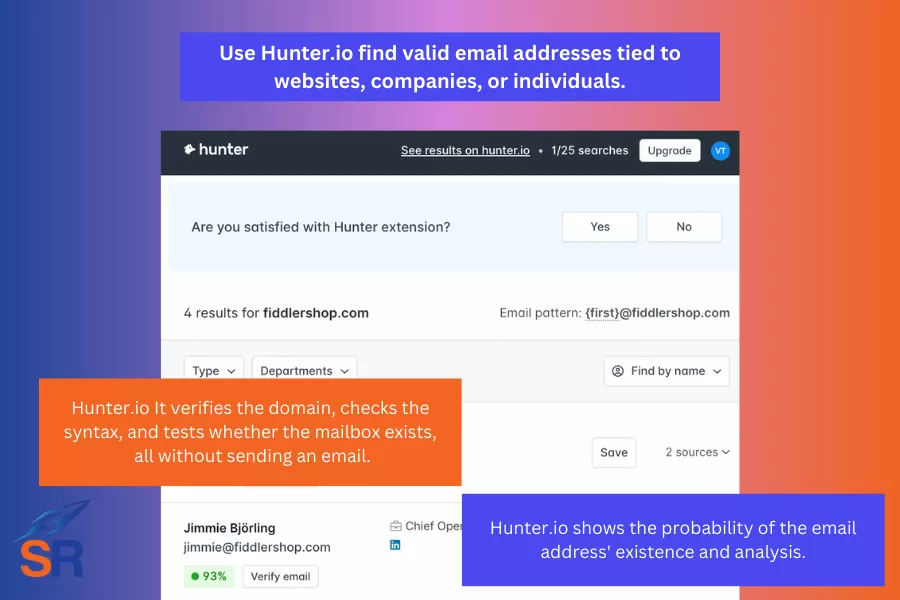
The best use of Hunter is that it helps you find valid email addresses tied to websites, companies, or individuals. Instead of manually searching for the contact person's email using Google or X search, you can click on the Hunter Chrome extension, which instantly gives you the available corporate emails.
The accuracy of finding emails for outreach is essential in ensuring you get positive responses in email, compared to randomly emailing non-corporate emails (which leaves you with no chance of responses).
Hunter is the best choice for targeted link building that caters to editors and specific departments of companies. It includes names, job titles, and departments, providing you with ready access to decision-makers and editors without wasting hours of time.
Another overlooked feature of Hunter is that it checks for deliverability in real-time. It verifies the domain, checks the syntax, and tests whether the mailbox exists, all without sending an email.
Email verification is crucial to reducing bounce rates, avoiding spam folders, and protecting your domain's sender score (though most link building agencies use a domain similar to their clients' domain for outreach to avoid flagging the real brand domain's sender score).
If you're a little nerdy, Hunter shows the probability of the email address's existence, which gives you the confidence that it is the actual email of the person you want to reach out to.
SharpRocket's Take on Hunter:
If you're doing a handful of link building campaigns, Hunter is ideal for solo SEO specialists or early-stage SEO agencies to streamline their process for finding email contacts (which, in our experience, consumes most of the link building efforts).
Its paid pricing of $34/mo saves you hours of manually searching for the right email address, which you can instead spend on major link-building tasks.
3. Journo (starts at $49/mo)
If you're monitoring digital PR campaigns and want to launch one for your website or for an agency client, you need tools to facilitate strategies such as expert commentaries, data-driven PR, and reactive PR.
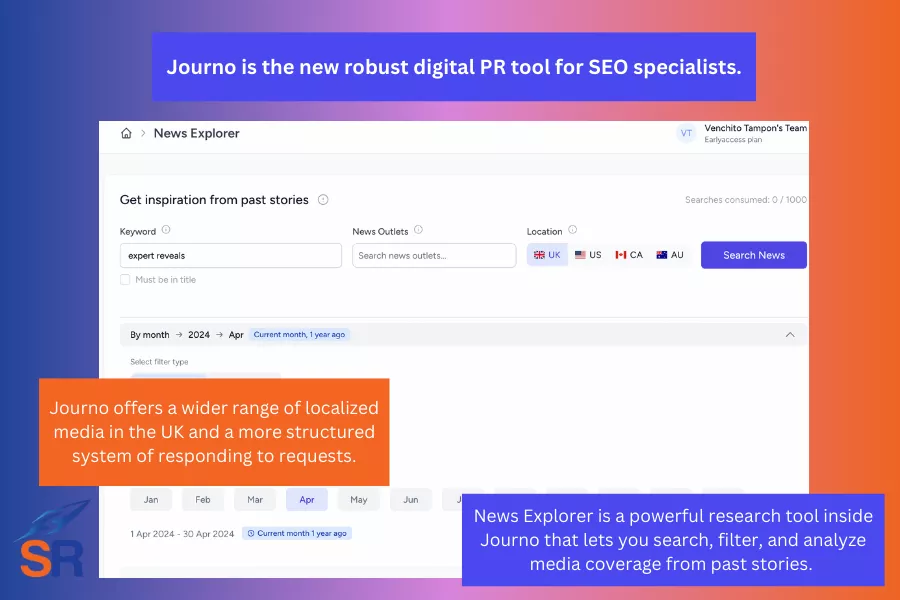
After HARO's shutdown, many PR professionals and SEO specialists have been looking for reliable alternatives to help them offer real media connections.
Fortunately, we have Fery Kazsoni of Search Intelligence, who's in the nitty-gritty of digital PR and recently launched his digital PR platform, Journo.
Unlike HARO, which is heavily US-centric focus, Journo offers a wider range of localized media in the UK and a more structured system of responding to requests. It doesn't overwhelm users with irrelevant queries but delivers targeted opportunities that align with your industry and expertise, making it easier to land quality brand mentions that come with earned backlinks.
Get Featured by Responding to Media Requests
Feature: Quote Responses
Journo gives you real-time access to journalist requests, which is the best use of the tool. These journalists seek expert inputs, brand examples, case studies, or quotes for specific stories.
It puts your business in front of journalists who are actively writing instead of contacting them firsthand without brand recall. Using Journo activates the discovery mode of journalists, which increases the chance your pitch gets noticed and positive responses.
Start by creating a client campaign and correspondents. These team members or client representatives will receive and respond to journalist queries. You could create a profile on behalf of an expert or be an industry expert.
Set up a profile with complete company details, position, description, and social media profiles. Make sure you have these filled out properly, as this is where journalists would likely base their decision on which correspondent to choose from, based on your expert inputs.
Once your profile is set up, you can proceed to Quote Responses.
What I like about Journo is that it filters responses based on the following:
- Industry or topic
- Status (pending, responded, urgent) - helps you prioritize the most urgent quote requests.
- Set bookmarks either with labels of topics or the client's name (i.e., tags)
These neat features help you organize your media requests, unlike HARO, where you can only categorize media requests using labels in Gmail.
Journo makes it easy for any SEO specialist or digital PR expert to respond to media requests using their clients' respondents' profiles. They know that the majority of users of their tools will be SEO, digital PR, and digital marketing agencies, so they make sure that responding to media requests is as seamless as possible.
They also have a feature where you can dictate your answer (using your microphone), so if it's not you would be responding, you can hand an expert from your team to dictate their answer (without them writing their inputs from scratch). You'll then edit their answer and send it instantly through the Journo platform.
Ask for Expert Insights to Add Credibility or Find Relevant Angles
Feature: Request Expert Quotes
This feature of Journo works in reverse: you submit a request for expert input. So, for instance, if you're writing a blog post, guide, or content piece and want to add quotes from real practitioners in your industry, you can use the tool to invite experts to contribute their insights.
Doing so helps you solidify your content assets with experience and expertise (E-E-A-T SEO approach), crafting more helpful content for your target audience.
Instead of soliciting expert inputs on X, LinkedIn, Reddit, and other platforms, you go straight to real experts hungry to give their contributions on Journo.
Generate Content Ideas for Digital PR Campaigns
Feature: News Explorer
News Explorer is a powerful research tool inside Journo that lets you search, filter, and analyze media coverage from past stories. The best part of this feature is its pre-determined keywords, which are exact titles and content ideas patterned after stories that Search Intelligence has encountered with its hundreds of digital PR campaigns.
For example, "expert reveals" or "survey reveals" makes it easier for digital PR or SEO newbies to find data-based or breaking news instantly without rigorously finding them on Google News or other news-related search platforms.
Journo's News Explorer also has other interesting features that make it savvy for data campaigns:
- By country - filter results by UK, US, CA, and AU.
- By data published - filter results by date published by year, month, or week.
- By news outlets - filter results by specific news outlets in the UK, US, or Global News (e.g., The Sun, The Verge, or Bloomberg).
This level of control helps you refocus your research and focus only on the stories that match your campaign goals.
For example, if you're planning a digital PR campaign targeted at the UK market, you can filter stories published in UK outlets in the past months and search for keywords like "survey shows" or "study finds." This reveals which data-led stories gained traction recently, inspiring your pitch's next content and direction.
You can also sort by "must be entitled" to find only stories where your keyword appears in the headlines. This is useful when studying what types of hooks catch editorial attention.
SharpRocket's Take on Journo:
Journo is an incredible tool for anyone in the digital PR space. It helps with the ideation and content creation process. Like any other tool, leveraging it for optimal success requires executing and aligning actions with campaign goals.
The real value comes when you dig deeper into the research phase and turn the ideas you generate using Journo into link-worthy digital PR pieces that actually reflect your current media interest.
4. Link Launch (Free)
One of the biggest challenges in SEO is proving the real impact of link building. LinkLaunch helps you justify the value of every single link-building investment. It combines traffic potential, cost modeling, and ROI forecasting in one dashboard, giving in-house SEOs and agencies the data they need to get more buy-ins from stakeholders (for in-house SEOs) and increase link building budgets with clients (for agencies).
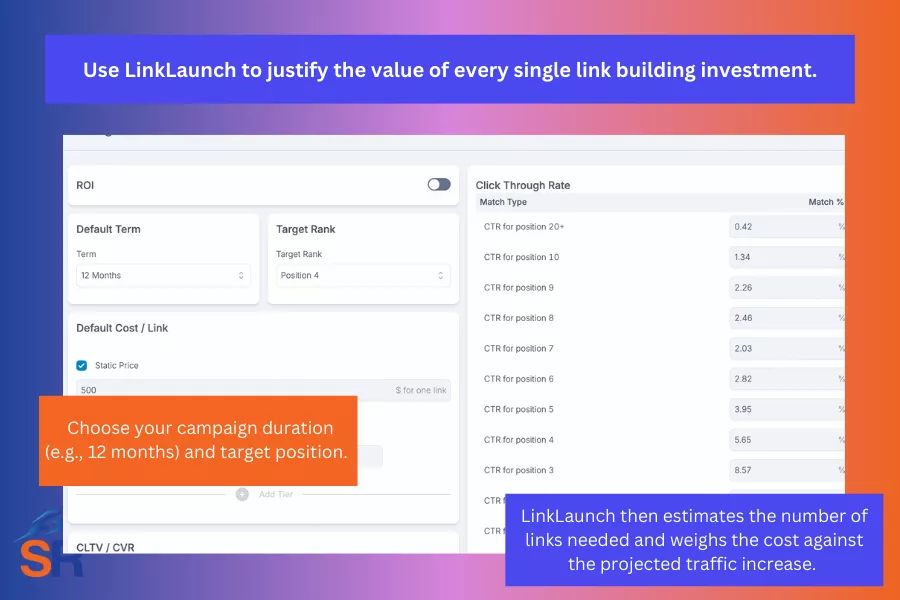
You can use LinkLaunch's Click-Through Rate (CTR) Model to forecast potential traffic gains. It already has default CTR data by search position. From here, you can set a realistic ranking goal (e.g., position 4). LinkLaunch calculates how much traffic each position could deliver for your keyword.
Then, tie it all together with the cost per link and ROI by setting a fixed cost per link (e.g., $250) or using custom pricing tiers. Choose your campaign durations (e.g., 12 months) and target position. LinkLaunch then estimates the number of links needed and weighs the cost against the projected traffic increase.
SharpRocket's Take on Link Launch:
Link Launch is incredibly useful to justify your link building investment or ask for increasing budgets to target more competitive keywords or sustain rankings. I recommend this for anyone doing SEO client work for agencies and enterprise SEO specialists who find it difficult to get approvals and buy-ins from stakeholders and defend links with data.
5. SmartLead (Free + starts at $39/mo)
There are many feature-rich and more popular outreach tools, such as Buzzstream and Pitchbox, which I personally tried and found to be highly useful for agencies and in-house SEO teams. Buzzstream is one of the simplest outreach tools, and Pitchbox is for scalable enterprise link-building campaigns with hundreds to thousands of link prospects.
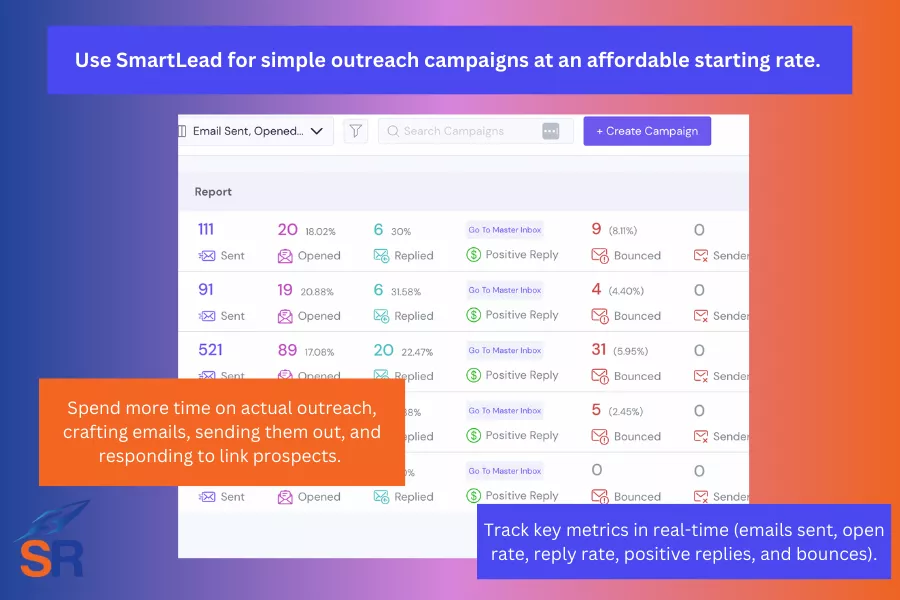
Among all these best outreach tools, our top pick is SmartLead, given its affordable pricing. It starts at $39/month for 6,000 emails per month, compared to Buzzstream's $24/month price for 1,000 contacts. SmartLead makes it feasible for anyone starting outreach campaigns or just having 1 to 4 small-scale link building campaigns.
Rather than figuring out how the outreach tool works, the easy interface of SmartLead allows us to spend more time on actual outreach, crafting emails, sending them out, and responding to link prospects.
Given that it can track key metrics in real-time (emails sent, open rate, reply rate, positive replies, and bounces), we can assess the results of each outreach campaign, even run an A/B test to see which performs well and refine the campaign as we see fit.
6. SEMRush (starts at $139.95/mo)
If you're only paying SEMRush for link building tasks, it's not worth it, given that its immense value comes from non-link-building tasks such as competitive intelligence, keyword research, site audits, and content gap analysis.
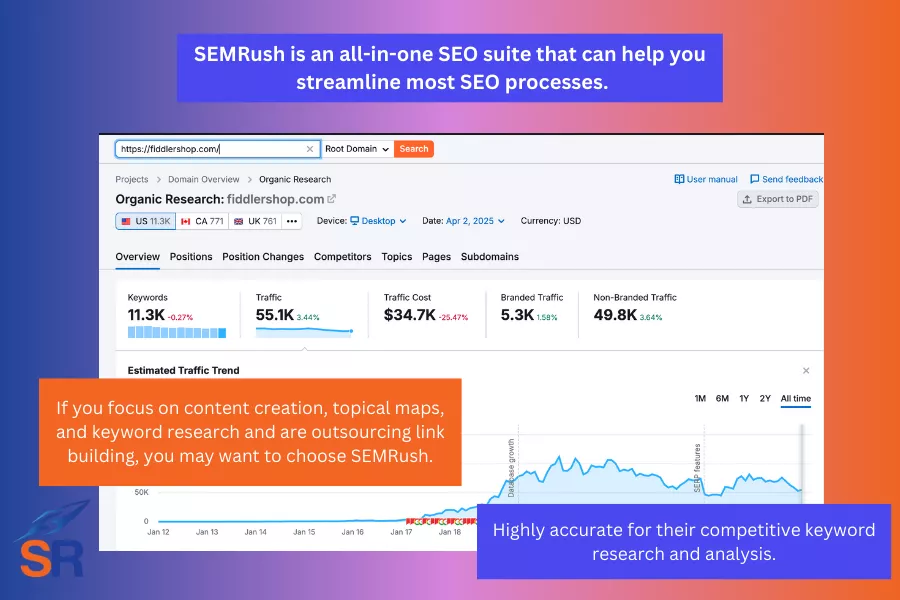
However, SEMRush is an all-in-one SEO suite that can help you streamline some of your processes, particularly in generating keyword ideas using actual data from your site, competitors, and other winning websites.
SharpRocket's Take on Link Impact:
If most of your SEO work involves link building, consider Ahrefs. If you focus on content creation, topical maps, and keyword research and are outsourcing link building, you may want to choose SEMRush, as it is highly accurate for this competitive keyword research and analysis.
7. Grammarly (Free + $12/mo)
Grammarly is actually a writing assistant, but it has helped us improve grammar, clarity, tone, and originality. While those things can easily be achieved with basic communication skills, for link building and SEO specialists, Grammarly helps ensure you're creating the highest-quality content possible, whether for writing guest articles, outreach emails, or internal content assets (guides, linkable assets).
Beyond its ability to assist in creating polished linkable assets, it helps to avoid duplicate content in guest posts by scanning them against billions of online sources to detect unintentional plagiarism.
Grammarly has been highly useful for outreach specialists in detecting the right tone, recommending softer or more direct alternatives, and tightening up long-winded sentences or awkward phrasing that could harm our outreach pitches.
SharpRocket's Take on Link Impact:
Grammarly isn't a direct link building tool, but it supports the vital process of content-led link-building campaigns: content ideation and editing. For teams producing content at scale, it adds a layer of quality control without slowing them down.
Which Tool Fits Your SEO Strategy?
The right tool depends on your campaign goals, team size, and, of course, budget. Below are helpful questions to help you decide what to use based on your specific SEO needs.
What Budget Do You Have to Work With?
If your budget is tight, free options like manual Google searches for link prospecting and limited versions of tools like Hunter.io can help you get started. These are best when you're still learning the ropes or handling outreach in small volumes.
But once you're scaling, investing in paid tools becomes necessary. So, tools like Smartlead, Buzzstream, or Pitchbox (for large enterprise link-building campaigns) can help automate outreach and follow-ups (saving hours of manual work).
For backlink analysis, investing in premium link intelligence tools like Ahrefs, MajesticSEO, or SEMRush is best to provide you with deeper data and better accuracy.
The bottom line is that if you're serious about link building and want real results, it's worth allocating part of your SEO budget to tools that increase speed, accuracy, and outreach success.
Are You Working Solo or with a Team?
You don't need full team features if you're a freelance or solo SEO specialist tasked with link building. You can use spreadsheets to help you organize your link prospects and outreach campaigns, which can take you far.
However, if you're working with a team, whether for an agency or with multiple websites as an in-house SEO specialist, then collaborative tools become essential. Link building tools like Pitchbox and Buzzstream let you assign roles, manage conversations, and track multiple campaigns under one account, helping you avoid duplicated effort, inefficiencies it may, and missed follow-ups.
How Much Link Data Do You Need?
Not all backlink analysis tools offer the same depth. If you need detailed, thorough competitor backlink profiles and link intersect features, stick to major link intelligence tools like Ahrefs.
Cheaper tools may look appealing but often come with smaller link databases or outdated indexes, which can lead you to miss high-potential link opportunities.
Do You Need to Report Results?
Clean reporting matters when working with clients, stakeholders, or internal teams. It shows them that clarity matters. So, tools like Ahrefs, SEMRush, SmartLead, and Pitchbox offer built-in reports with visual summaries, link status updates, and campaign metrics.
If you spend hours building reports manually, switch tools with auto-reporting features (of course, you'll make filtering with the exported data only show what matters).
See our link building services if you need help facilitating these link-building tools. We'll do all the legwork for you. Book your strategy call.
How Much Does Link Building Cost in the UK in 2025?
How Much Does Link Building Cost in the UK in 2025?
Link building pricing UK can range from £150 to over £950 per link, depending on the quality of the link, the authority of the referring domain, and the difficulty of your niche. A typical campaign budget runs between £500 and £15,000 per month. Lower budgets tend to focus on small placements, while higher budgets support larger-scale outreach, better-quality domains, and more supporting content.
What Determines the Cost of Link Building?
The cost of link building is not fixed. It depends on three major factors:
- The number of links you want to build
- The quality of each link
- The difficulty of your industry or niche
Understanding these factors helps you plan your link building budget wisely, whether you're managing SEO in-house, working with an agency, or pitching a link building campaign to decision-makers.
Below, I break down how each of these elements affects link building pricing in 2025.
The Number of Links You Want to Build
The more backlinks you want to build, the more budget you'll need to allocate. Each link is acquired using resources, including time for content creation, outreach, and link prospecting, as well as budget and capabilities to write internal and external content assets to get the links.
Whether you're running a small business campaign or a full-scale SEO operation, link volume is a direct cost multiplier.
For internal teams, securing higher volumes of links often means getting additional budget approval from senior leadership (either the Head of SEO or even directly the company's CEO), especially if monthly SEO costs are expected to grow significantly.
For SEO agencies, higher link volumes often unlock better operational efficiency:
Bulk Discounts
Many link building agencies offer bulk discounts to clients who order a high volume of links. As the number of links increases, the cost per link often decreases, a typical strategy agencies use to encourage long-term partnerships and retain clients.
It's a win-win scenario: clients gain better pricing, while agencies benefit from predictable workloads and revenue, making scaling link acquisition more cost-effective over time.
Streamlined Teams
When clients commit to larger link building campaigns, agencies can allocate full teams to the project, including dedicated outreach specialists, link builders, and content writers. With a good workforce focused on a single campaign, tasks are completed faster, quality is more consistent, and communication becomes more efficient.
So, instead of juggling multiple small projects, the team follows a single strategy with clear goals, leading to faster turnaround times, smoother coordination, and fewer delays. This structure allows for a more streamlined workflow and helps agencies deliver better backlinks at scale.
Link Metrics That Determine Quality
Better links cost more, given that they are hard to earn and carry more SEO value. These links come from legitimate websites with real credibility, organic traffic, and authority.
Compare a low-quality link that costs £15 from a pure link directory (that offers zero SEO impact to your site) to a topically relevant editorial link that costs you £150 but passes more link juice, trust, and authority to your site.
Here are the key factors that influence link quality and pricing:
1. Topical Relevance
A link from a high-quality website in your niche sends a stronger signal to Google than a general site. For instance, if you're doing link building for SaaS, you should aim for links from tech or software publications, not lifestyle blogs. Another example is a UK-based legal firm that can benefit more from links on law-focused UK domains than international news outlets with no legal content (unless it's a digital PR campaign).
2. Organic Traffic
A website's organic traffic is a good measurement of link quality; as you can see, it gets traffic from search, which means it ranks for some of its pages. Check the site's organic ranking keywords to see what phrases it ranks well for its web pages.
Some sites with high DR scores may have very low organic traffic, as they only rely on manipulative SEO tactics. So pay attention to these DR70+ sites with 50 monthly visitors; they are not worth your link investment.
3. Advanced Link Metrics
Our link building agency works with enterprise brands, and we often do more than just basic link vetting.
Here are extra signals that helped us reveal deeper link quality.
| Metric Category | What to Look For |
|---|---|
| Backlink Profile | Natural follow:nofollow ratio and backlinks from a wide range of referring domains. |
| IP & Subnet Diversity | Links should come from varied IPs—not clustered in one network (a sign of PBNs). |
| Traffic Source Geography | Sites with traffic from your target country (e.g., UK for UK-based businesses). |
| Content History | Consistent publication of original, valuable content—not just guest posts or link inserts. |
| Network Graph | Links to and from other reputable sites, not just commercial or affiliate-heavy pages. |
4. Site Credibility Checks
Run a quick test to see the trustworthiness of a website. Few assessment checks:
- Does the website have an About page?
- Are the site owners or authors listed?
- Is there an editorial team or company behind the brand?
- Are there signs of user engagement (e.g., comments, social shares)?
- Does the content reflect real expertise?
You want to get links from websites that send search engines trust signals. These signals show that a site is real and credible and not part of a manipulative link scheme.
Industry-Specific Factors
The difficulty of your industry adds to the factors in link building pricing. Some niches find it harder to secure placements due to legal, editorial, or reputational constraints, which drives up the cost of link building.
Examples of these difficult niches:
- Finance and banking - regulated industry, most publishers enforce strict guidelines, and reject commercial links
- CBD & cannabis - legal status varies by country; many mainstream sites avoid these topics entirely.
- Gambling & iGaming - high legal and advertising restrictions, limited publisher pool, and risk of spam classification
- Legal - fewer relevant and authoritative legal blogs. Many require high editorial standards
- Crypto & Blockchain - considered volatile or scam-prone by many publishers, and fewer credible link sources
In these industries, the likelihood of acquiring backlinks organically is lower, and it's about overcoming editorial hurdles, compliance concerns, and reputation risks.
You will need writers who understand the subject matter and can create content that meets legal and editorial standards. In finance or healthcare, for instance, outreach pitches go through multiple layers of review.
Beyond Link Value: Other Associated Benefits of Link Building
When calculating the ROI of link building, it's easy to focus on a single number: the monetary value of one link based on traffic or rankings. While that metric is useful, it doesn't capture the full impact of a successful link building campaign.
Backlinks influence more than just keyword positions. They touch multiple areas of digital marketing, supporting brand growth, trust, traffic, and future SEO efforts. If you ignore these associated benefits, you could undervalue the real return on your link building investment.
Here are some ways link building adds value beyond just direct SEO metrics.
Brand Visibility and Authority
Links from reputable websites expose your brand to new audiences in your target market. For instance, when your brand is mentioned in a high-traffic industry publication or media outlet, it puts your name in front of readers who may not have discovered you otherwise.
Even if these readers don't click the link, the brand impression sticks, and over time, the repeated exposure through multiple mentions helps position the business as a trusted voice in your space.
Referral Traffic That Converts
Some links can help bring actual users. When a backlink appears on a contextually relevant blog post (e.g., product comparisons, expert lists, tutorials), users are more likely to click the link and more likely to convert into actual customers.
Conversion-focused link building happens when one strategic link brings sustained referral traffic for months or years.
Faster Indexation and Improved Crawlability
Backlinks act as discovery pathways for search engines. When your pages are linked from established domains, Google can find and crawl your content faster. This is helpful mainly for newly launched websites, large eCommerce brands with new product pages, and blogs publishing frequent content updates.
The result is that your content appears in search results quicker, giving you a faster return on your content publishing efforts.
Trust Signals and Social Proof
Being featured on credible sites can help increase your website's trustworthiness for search engines and users. When potential customers see your brand mentioned in known industry publications and media coverage sites, it acts as social proof.
You can repurpose these mentions in your own brand assets:
- Add publisher logos to your homepage or press kit ("As Seen On").
- Mention features in your email campaigns or Ads.
- Use links in pitches to partners, clients, or investors (and to more link prospects to increase chances of more links).
Builds Up Overall Domain Authority
The value of a backlink continues to support your overall domain authority, helping future content rank faster, even if that content never earns its own backlinks.
By domain authority in its own merit, the compounding effect helps you publish content that ranks with minimal promotion and compete on more competitive keywords over time.
Strategic POV From Competitors
Link building helps strategically differentiate your brand from others in your space. Building strong backlink relationships gives you a distinct edge in building thought leadership, expanding influence in key online communities, and relationships with publishers that may lead to future PR or partnerships.
SharpRocket: Link Building Agency of Choice
SharpRocket offers UK businesses a strategic, data-driven approach to link building with a clear focus: quality over quantity. We help enterprise brands, eCommerce, and SaaS secure links from our content-driven link building campaigns.
If you're ready to invest in link building that supports your brand for the long haul, we're ready to help. Learn more about our link building services and book your free strategy call.
White Label Link Building Guide for Agencies: Process and Best Practices
I've had conversations with companies and SEO agencies directly outsourcing their white-label link building projects to developing countries like the Philippines, where a skilled team can deliver topically relevant backlinks at a lower cost.
Without building an internal outreach team, these agencies want to scale fast, meet client demands, focus on their core SEO strengths, and keep profit margins healthy.
White label link building services allows them to do exactly that. They focus on client relationships, strategy, and reporting while their offshore team handles the heavy lifting: prospecting, outreach, content writing, and link placement. This setup works well for both sides and is becoming a common business model in the sEO industry.
In this guide, we'll cover what white label link building is, who uses it, how it works, and waht to look for in a provider. If you're an agency looking to grow without hiring, this guide is for you.
What is White Label Link Building?
White label link building is an offshore service where the SEO provider builds backlinks on behalf of another agency. The agency delivers the results to its client under its own brand, putting all the legwork for its link-building partner.
Who Uses White Label Link Building Services?
White-label link building is widely used by service-based agencies that want to offer SEO without doing the actual link building work. These businesses resell link building under their own brand while a third-party provider does the research, outreach, and content placement.
Here are the most common types of users:
1. SEO Agencies
Some SEO agencies handle keyword research, technical audits, and content strategy but outsource link building to save time. Instead of fully hiring an outreach team, they work with a white-label partner to build the right types of backlinks at scale.
2. Digital Marketing Agencies
Agencies that focus on social media marketing, paid ads, or email marketing often add SEO to their mix of services. Since link building requires a separate skill set, they use white-label providers to deliver results without hiring more people and creating a new set of in-house processes to train link buliding specialists.
3. Web Design and Development Companies
Web agencies build websites and often get asked by clients how to rank better on search engines like Google (and show up on LLMs like ChatGPT and Perplexity). Instead of saying no or referring the client elsewhere, they offer link-building through a white-label provider and keep the business in-house. They operate this way to increase their client base and get more margins.
4. Freelancers and Solo Consultants
Freelancers who manage SEO for clients may not have the time to do outreach or write external content ("guest posts") to acquire backlinks for their clients. With white-label support, they can take on more clients and deliver results faster.
5. Startups and Niche Service Providers
Smaller agencies or startups that are growing quickly may not yet have full SEO capabilities, as many are focused on product or service delivery, other marketing channels, and customer service.
White-label link building lets them offer results-driven services while focusing on client relationships and sales. It also enables another B2B type of service (offering SEO services besides their core product offerings).
Benefits of White Label Link Building for Agencies
White label link building gives agencies a clear path to grow their SEO services without increasing internal workload. It's a practical way to meet client demands, keep operating expenses low, and improve performance—all under the agency's brand.
Below are the most important benefits of hiring a white-label link-building partner.
Scale Without Hiring
Many agencies hit a ceiling because they lack the resources, team, and capabilities to handle high-volume link building. Hiring, training, and managing a full-time outreach and content team takes time and money, let alone taking months to fully systematize the process and quality of results.
White-label link building actually removes this barrier. Agencies can serve more clients, take on larger projects, and expand their offerings. This makes it easy to grow from 3 to 50 clients without changing internal operations. The partner handles execution, while the agency focuses on client acquisition, account management, and reporting.
Faster Project Completion
Link building involves many steps: link prospecting, backlink qualification, outreach, content creation, and outreach follow-ups. By leveraging white-label link building services, you take these steps systemized. They have outreach templates, active contact lists (relationships with publishers, bloggers, and journalists), and content teams ready to work.
You can report all lives links at the end of each month (as part of your SEO reports), avoiding delays that comes with lack of manpower and capabilities for in-house link building.
Lower Costs and Better Margins
Building an internal team involves fixed costs: monthly salaries, software subscriptions (e.g., Ahrefs), training, and management overhead. White-label providers operate on a per-link or per-campaign basis, making the costs of outsourcing more flexible and predictable.
Agencies can simply mark up the service and offer it to clients at a profit, increasing the overall revenue without adding extra burden to the team.
Access to Experienced Link Building Experts
White label providers specialize in link building, many are fly-by-night companies, but there's still a handful of best white label link building agencies like SharpRocket that truly has mastered the craft of link development.
They have rigorious processes, systems, high-level capabilities, and inside-know hows for every industry, that strengthens their core service in providing the highest quality of backlinks.
So, agencies gain access to this type of expert-level service without spending months building even the basic skills themselves, which ensures links meet the quality standards.
Your Branding, Your Reputation
White label means the client never sees the third-party provider, this both takes pros and cons scenario, where if the agency fails to meet the link requirements, it could negatively affect the branding of the agency and failing to meet desired expectations and results.
However, if they hire the right white label link building partner, and it delivered what they agreed upon, it significantly impacts the agency's reputation, building client trust even more, and avoids any confusion about who's doing the work—this keep the agency's brand front and center.
How It Works: The White Label Link Building Workflow
There's nothing complicated with white-label link building. If follows a clear process, where the agency manages the client, the provider manages the links. The clients sees the results, but only the agency's brand is visible.
Here's how the process usually works, step by step:
Step 1: The Agency Signs a Client for SEO Services
The agency offers SEO services to its clients, or upsells it from another service they already render. For instance, after working on a website revamp, they found issues to solve, by optimizing better their client's website to help them gain more search traffic.
As such, they offer a full SEO package that includes technical SEO, on-page SEO, content strategy, and link building. When a client signs up, the agency includes link building as part of the package, even if they don't handle it in-house, or if they do, they don't have the capability to scale the work.
Step 2: The Agency Submits a Link Building Request to the Provider
The agency sends a request to the white label partner, which includes links that pass on certain link metrics (e.g. Ahrefs' Domain Rating, organic traffic (estimate), topical relevance), as well as the number of links pointing to desired target pages.
Some providers, with SEO consultants, suggest link targets or provide recommendations as to how many backlinks to build each month based on the client's website domain authority and how fast to acquire links ("link velocity").
Step 3: The White Label Provider Handles Prospecting, Outreach and Content
The white-label link-building agency starts and executes the actual link building process, which includes:
- Finding relevant websites in the client's niche (link prospecting)
- Qualifying backlink sources based on set link metrics
- Reaching out to editors or site owners (email and other forms of link outreach methods.
- Pitching for either link inclusion, link request, or value-add outreach forms (i.e. content, data, visual assets, co-marketing, etc..).
White label partners share a live dashboard or spreadsheet that shows every live link each week and provides a detailed backlink reporting at the end of every month (or agreed timeline for reporting).
Different agreements between agency and provider has unique expectations, timelines, and deliverables in their own right. However, having a good workflow will help agencies stay efficient and effective, so they can focus more on agency growth, communication, and strategy.
Risks and How to Avoid Bad Link-Building Providers
White label link building can certainly help your agency, but only if the provider delivers top quality. Bad links can negatively affect your clients' rankings, trigger penalties, or lead to lost trust (and of course, waste of money and resources).
Below are common risks and how to avoid them:
Spammy or Low-Quality Links
There are many fly-by-night agencies that offer cheap links, mostly placed on PBNs (private blog networks), link directories, or websites with poor content and low authority. These sites often exist only to sell backlinks and have no real audience or actual organic traffic (they're not ranking by themselves for any relevant keywords).
Make sure you ask for real examples of live backlinks before committing to a white label link building agency. Visit the websites to see if they are active, and topically relevant. You can use tools like Ahrefs to check the sample's link hosted website, and see if they have organic traffic and decent backlink profiles.
Irrelevant or Off-Niche Placements
Connected to what we mentioned earlier on link metrics, getting backlinks from unrelated websites weakens any SEO strategy and is only a pure waste of time.
So, confirm if the white-label link-building service can provide backlinks that are topically relevant to your industry (either giving you actual live backlinks or case studies with industry-relevant clients).
No Transparency in the Process
Some white-label link-building providers do not share where the links are placed, how they do outreach, or what the content looks like—all look suspicious. This lack of visibility makes it hard to measure the quality of their work or explain actual results to your clients.
Work only with providers who offer full link reports with URLs, anchor texts, domain, relevance, organic traffic metrics, and placement context. Avoid providers who withhold key information.
Missed Deadlines and Poor Communication
A provider who delays delivery or fails to respond to emails can hurt your workflow. Your client expects regular updates. If you don't receive links on time, your agency's credibility takes a hit.
So, start with a small test in order to evaluate responsiveness. You can ask about delivery timelines before signing any agreement. Check if they have a dedicated account manager or support channel, or directly you to talk to their agency's founder or CEO, much like with how SharpRocket operates their white label link building services.
Duplicate Content or AI-generated Junk
Some providers obnoxiously use low-quality AI content or duplicate articles to get links placed quickly, and more often than not, these articles are rejected by editors. They don't contribute any value to the website's SEO and its ability to be recognized as helpful content.
Ask who writes the content (if they're written by native English writers or are done in-house or completely outsourced). Review sample guest posts to check writing quality.
Best Use Cases: When White Label Link Building Makes Sense
White label link building fits where it needed the most. Here are some common scenarios where white label lin kbuilding provides strong support and practical advantages.
During High-Growth Periods
When your agency signs multiple new clients in a short time, link building can become a bottleneck. Prospecting, outreach, and content creation all take time, resources, and capabilities; even with a solid SEO team, delivering quality links for several clients at once can overwhelm your internal resources.
Outsourcing link building makes sense if you want to handle a higher volume without missing deadlines or lowering quality.
When Launching New Services
Many agencies start with services like web design paid ads or content writing, then offer to cater more with SEO and link building. Building an in-house team for a new services takes time (than people expect it to be), and the learning curve can be steep.
White-label link building gives you the confidence and the ability to launch an SEO offer right away (of course, with the right market fit and expertise). But for link building alone, you don't need to hire outreach specialists and writers. You get a complete execution system under your brand, allowing you to test, improve, and scale the new service faster.
When Clients Expect Faster SEO Results
Some clients expect noticeable SEO progress in the first few months. While content and on-page work take signficant time to show results (usually 6 to 12 months), high-quality backlinks can speed up rankings and visibility (with the right technical SEO, on-page SEO and content foundation in place).
White-label providers already have systems in place—relationships with publishers, active outreach pipelines, and writing teams. They can deliver links faster, enabling you to meet client expectations and show early quick wins in your search engine optimization campaigns by tapping low hanging fruits.
When Quality Control Becomes a Priority
As your agency grows, maintaing consistent link quality becomes more difficult. Different team members may use different link building strategies and outreach methods, content may vary, and results may not align with the SEO strategy.
A strong white label SEO partner uses a tested and repeatable system, follows guidelines, uses approved anchor text mixes, and provides full-detailed reports. You need this consistency across all your client campaigns.
When Entering a New Geographic Market
If your agency is expanding to a new country or region, you may not have local contact or publlishers to support link outreach.
It makes sense to have a white-label link-building provider with global reach or region-specific link sources that can help you build location-relevant backlinks, especially if they already operate in that target region (e.g., UK, US, AU, or Asia-based placements).
When Competing for Highly Competitive Keywords
As obvious as it may sound, ranking for competitive keywords often requires authoritative and robust backlinks from high-authority websites.
Generally, white-label providers have existing relationships, ongoing outreach campaigns, or a solid strategy to tap these A-tier publications that can help place your links faster on high-DR websites—helping you close authority backlink gaps quicker.
SharpRocket, The Philippines' Top White Label Link Building Provider
Since 2015, SharpRocket has been delivering quality link-building services to SEO agencies, eCommerce founders, and enterprise in-house SEO specialists. We've helped clients from startups to Fortune 500 companies scale their link building projects with topically relevant and authoritative links.
Need help with link building? See our link building services and schedule a strategy call.
Advanced Link Building Strategies in SEO for 2025
Backlinks remain one of the strongest signals that influence rankings. Even with all the changes in how users search (AI overviews, featured snippets, and LLMs like ChatGPT and Perplexity pulling answers directly from the top results in organic search listings), link building would remain a vital component of SEO.
Given that AI tools reference trusted sources, if your site, product, or content is cited often, it has a better chance of showing up as a referenced authority in search results and AI summaries and answers.
This shift makes link building not just an SEO tactic but has become part of your brand visibility strategy. It helps in the overall packaging of your brand on search, helping you strengthen the following:
- Discovery - making sure people find you from organic search listings, LLMs, and curated bottom-of-the-funnel content of other publications.
- Reputation - proving you're a trusted source of information in your space.
- Conversions - sending traffic from diverse sources (referral traffic from other curated listings, ChatGPT, forum discussions, etc..).
- Brand positioning is at the top of your mind and the top of the search, as your target audience may find you in different places.
Link building is no longer a game of pushing rankings; it is now a game of maximum visibility, where more visibility can help influence the purchasing decisions of your target customers.
In this guide, I'll discuss advanced link-building strategies that go beyond the basics and help you stay visible in an SEO landscape shaped by AI and brand authority.
1. Citation-Driven Links
Search engines and AI tools like ChatGPT depend on sources they trust. These tools don't just look at who has a link. They look at who gets mentioned often across the web. This is where citation-driven link building becomes a powerful strategy.
What Are Citation-Driven Links?
Citation-driven links are backlinks from sites that mention your brand, services, or content in a trusted context. They are references found in curated lists, industry roundups, tool directories, and comparison content pieces (pages where decision-makers actually go to evaluate options).
AI Overviews, ChatGPT responses, and search engines use these mentions to assess credibility. If your website is included in well-known directories, comparison articles, and tool roundups, it tells algorithms your brand is relevant, trusted, and deserves its proper visibility.
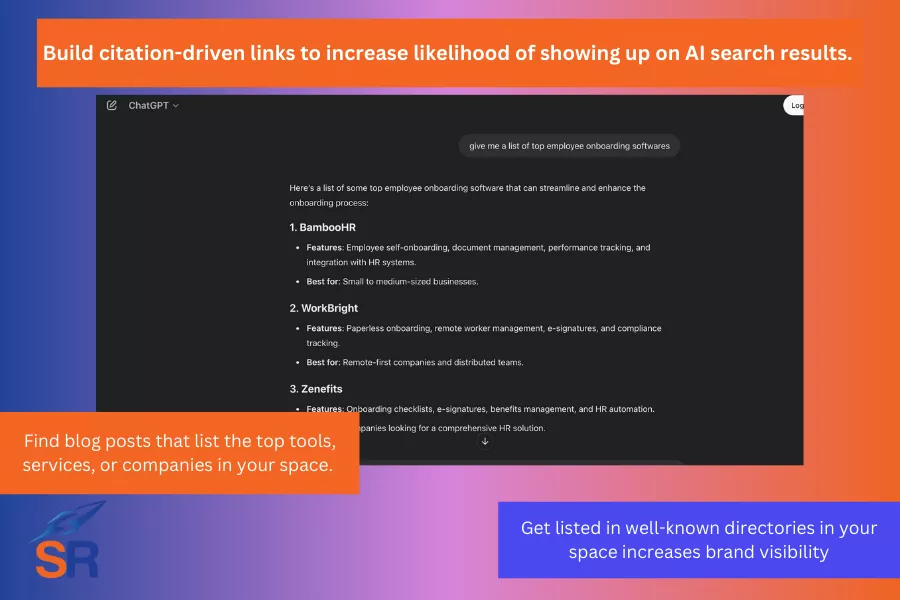
How to Earn Citation-Driven Links?
Focus on getting featured in content where people are already looking for solutions. Here are actionable tips to help you earn citation-driven links:
Pitch for Industry Roundups
Find blog posts that list the top tools, services, or companies in your space. These roundup pages already exist and are visited by people ready to decide. Your link building goal is to get your brand featured.
For instance, if you're promoting a project management tool (a highly saturated space), you can search for roundup articles like "Top Project Management Tool for Remote Teams" and "Best Trello Alternatives For Agile Teams."
These similar posts attract high-intent readers and could influence LLMs (with the listicle posts that rank) to feature your product as one of the go-to solutions.
Use an angle that makes your product stand out instead of a random, desperate email outreach pitch. Instead of just saying, "Please include this tool", show why your tool deserves a spot. You can say:
"We'd love to be considered for your list of top tools for remote teams. Our platform has built-in video collaboration and task tracking that eliminates the need for separate Zoom calls—something many remote teams actively seek."
Add credibility with results, use cases, or testimonials. If possible, share a client success story or specific outcome.
"One of our users reduced weekly meeting time by 40% after switching to our tool. We believe your audience of remote team managers would find value in that."
Offer something in return to increase your chances of link placements in those citation-driven pages. Mention that you'll share the post with your accounts once you're included to get more reach, or suggest adding a helpful quote or stat to make the post more comprehensive.
Roundups exist to help readers compare, so highlight what makes your offer different or valuable from their point of view.
Submit to Trusted Directories
Getting listed in well-known directories in your space increases brand visibility and the likelihood of being cited in AI answers.
Circling back to our example earlier, if you're offering a project management app, you can target trusted directories to be listed, like:
- Product Hunt
- G2
- Capterra
- GetApp
- Software Advice
These platforms are often the first stop for people searching for tool reviews or comparisons (in fact, many software users go directly to those tool comparison sites to find credible tools). Those trusted directories often appear in AI summaries, listicles, and Google's top results for "Best X for [use/purpose]."
To maximize your product listing, write a clear, benefit-focused profile. Focus on your product's purpose and how it helps. Use keywords naturally so AI and search engines understand what you offer.
"A project management app built for remote marketing teams. Features include time tracking, real-time comments, and integrated campaign dashboards."
Ask your users to leave honest feedback. Reviews will help you stand out and influence decision-makers.
You may also add visuals and product walk-throughs. Include screenshots or videos that explain your key features, improving your engagement and increasing your chances of being cited by bloggers or roundup writers.
2. Strategic Content Placements (Link Insertions)
Many people are familiar with the term "link insertion" or "niche edits" when it comes to strategic content placements. These are about earning links from existing content that already has value.
Instead of writing a full guest post, you insert a backlink into a relevant paragraph of a published blog or article that is contextually worthy for the publisher to include your short-form content.
Search engines trust pages that are aged, indexed, and performing well in page rankings (they rank for keywords, able to get search traffic).
Adding your link to one of these strengthens your destination page by association, so you're not building from a newly indexed page or an article with a proven SEO value.
Start with the right blog posts. Target high-quality blog content, not just any random blog, to get the best results. What you should be looking for:
- Blog posts with organic search traffic
- Topic that fit naturally with your content
- Sites that are open to updating older posts
Prospect for industry-relevant blogs and publications. Then, use the advanced search operator (site:domain.com "topic") to find indexed articles of the target website. This helps you locate specific pages where your content could fit.
Then, you can use tools like Ahrefs or SEMRush to check if the domain gets traffic before diving into specific articles. You can filter for blog posts with organic traffic of 50 or 100>/month and page content with relevant topics or keywords.
When pitching to these bloggers, make sure that your destination link makes sense for them to include in their existing content. If you're linking to a content marketing tool, don't force it into a post about web hosting (it would only dilute your website's off-page SEO relevance).
Instead, find blog posts discussing similar services, related informational content, or complementary tools. The link should enhance the page's content, not distract readers.
Many publishers would appreciate getting pitches to improve more of their old content, particularly with the intent to add or regain the search traffic that may have been lost.
When pitching to publishers, you can offer value, such as improving the article with fresh data or adding a unique perspective on the article where it makes sense to link to your destination page for additional reference or resources.
3. Digital PR
Digital PR has become a core strategy for many SEO and digital marketing strategies. It helps clients earn brand mentions and links by sharing stories worth covering.
The brand strategy works well, given that journalists, influencers, and content creators always look for credible sources, fresh insights, and original data to cite in their articles.
Digital PR links are editorial and natural and often come from media sites or top-tier blogs, making them robust for SEO and brand visibility.
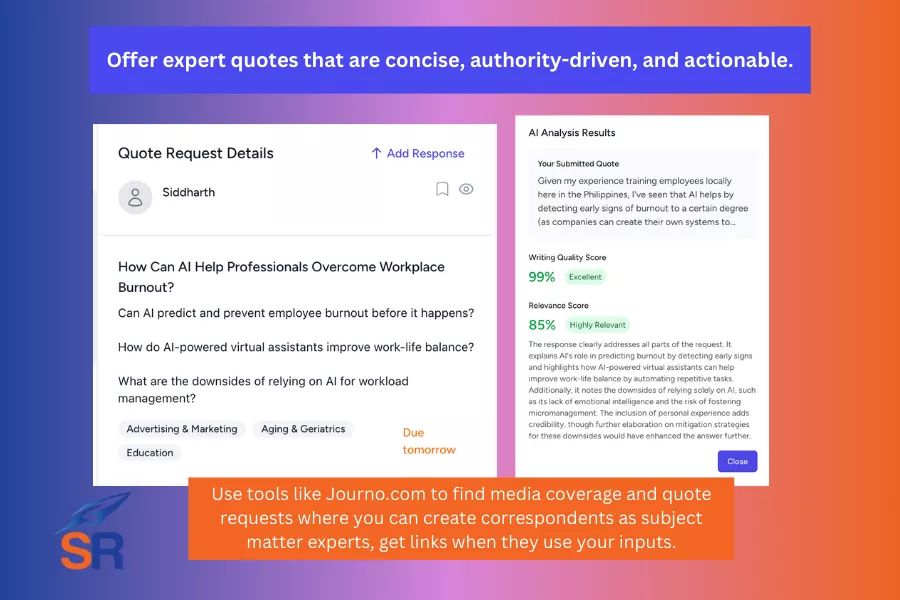
Expert Commentaries
One powerful way to do digital PR is by offering expert quotes to journalists that help share the story they're writing. As reporters by profession, they can't simply quote their own opinions. They need external inputs and credible insights to support their content, making their written content more trustworthy.
The best quotes are:
- Concise (answers what they look for: tip, insight, or trend).
- Authority-driven (use data, experience, or unique takes)
- Actionable (something readers can think about or apply)
There are a couple of platforms where you can find quote requests and media opportunities, including:
- Journo (new quote request platform by Search Intelligence UK)
- Qwoted
- Featured.com
Another way to leverage expert commentaries is to send direct pitches to writers or editors. If you have an interesting list of tips relevant to your industry by first search for what topics they religiously write for (based on the past year's content), you can nudge them with your own sets of tips that will benefit their readers.
Make sure you track these opportunities using Ahrefs or Google Alerts. Thank the writer and stay on their radar for future stories.
Reactive PR
Reactive PR is all about speed and relevance.
You earn backlinks by quickly responding to trending topics, breaking news, or cultural moments with expert insights.
Unlike general digital PR, where you wait for coverage, with reactive PR, you insert your brand into the conversation while it's still hot. So, the faster you react (in digital PR terms), the higher the chance your quote gets featured and your website gets cited.
It works because journalists and content creators move fast. When a story breaks, or a topic goes viral, they need expert input immediately. If you're one of the first to offer a relevant comment, tip, or angle, you become the source they quote.
Start reactive PR by monitoring the news. You can use platforms like:
- Google News – Track industry keywords and breaking headlines
- Twitter/X Trending Topics – See what's being discussed now
- Subreddits – Join niche communities in your space
- BuzzSumo / Exploding Topics – Catch early content trends before they peak
You can choose one or a combination of many to get more trending news as fast as possible.
Create a reactive content calendar to harness the power of trending news. Map out important days and events such as:
- Upcoming Holidays
- Industry-specific awareness weeks
- Annual news cycles
- Recurring events (like product launches, sports finals, seasonal changes)
Instead of passively waiting for links, you build a system that maximizes reactive PR and has it ready. This way, you can respond within hours, not days.
Data-driven Campaigns
This is one of the most reliable ways to earn press coverage using digital PR campaigns. Unlike reactive PR, where you wait for breaking news to take advantage of, data-driven PR involves publishing original data that supports a specific insight.
For the UK, US, and AU countries, journalists and bloggers love using fresh stats to strengthen their upcoming articles, and when they do, they credit you with the backlink (most to your homepage).
Here are a couple of ways to generate valuable data, even with a small team:
- Quick internal surveys: Send a short survey to your audience, email list, or LinkedIn connections (e.g., see State of Link Building Report or SEO Agency Survey).
- Customer usage stats show how users interact with your product or service. Your platform's insights are unique, making them difficult to replicate.
- Market research: Use tools like Statista, Office for National Statistics (UK), Google Trends, or industry reports to pull data and then reframe it (or combine it with your other sets of data) to produce high-utility data insights.
- Publish data re-analysis - pull government or academic datasets and analyze them with a fresh angle (e.g., "Using data from the Bureau of Labor Statistics, we ranked the top 10 fastest-growing freelance jobs in the U.S.").
You can check our guide on digital PR tips for successful campaigns.
4. Integrated Linkable Assets to Landing Pages
In the past, the long-term SEO strategy has been built around creating linkable assets to attract passive links, coupled with using them as a value proposition in manual outreach to get an initial set of links. From there, attracting link opportunities from publishers at their writing stage becomes more visible as the linkable asset ranks for informational research terms.
The model worked for traffic and got dozens of high-quality backlinks, which you can leverage further by internally linking from the most-linked page to commercial pages. This way, the links will pass SEO value to landing pages, increasing their chances of ranking for their respective keywords.
Linkable asset creation was isolated. It created a unique backlink, but it didn't connect directly to pages that drive leads or sales.
The best approach for developing an advanced link-building strategy in SEO is to integrate linkable assets into your landing pages and core site architecture. Surrounding it through topic clusters that push value toward your key pages helps in so many ways, such as:
- Backlinks earned by useful content also benefit pages where you convert visitors (no more internally linking from linkable page to commercial page).
- Authority flows naturally through your internal structure.
- Your highest-priority page ("commercial pages") gets stronger rankings, not just blog pages.
By doing so, your most important pages—those that drive sign-ups, leads and
Instead of keeping your content separate, you:
- Build tools, visuals, or mini guides directly inside your landing pages.
- Create topic clusters where blog posts link to service or product pages.
- Turn high-converting pages into link-worthy resources, not just sales copy.
- Make purchases and start earning natural backlinks, too.
Don't treat content and conversion as separate. Think like this, "how can I make this page so useful that someone would choose to link to it?".
Here are actionable tips for integrating linkable assets into landing pages:
Create Landing Pages with value-added content.
Enhance product or service pages with:
- Interactive tools (e.g., calculators, ROI estimators, checklists)
- Quick-start guides or "how to use this" sections
- Case study snippets that give real-world proof
- Infographics that explain processes visually
For example, a time-tracking SaaS tool can include a "Time Theft Calculator" on its product page, giving publishers and media outlets a reason to link directly to that page when discussing workplace productivity.
Support Pages with Strong Internal Links.
Build help articles, tutorial pages, and onboarding content that support your primary services. These can act as natural backlink targets when people search for instructions, definitions, or "how it works' content.
From there, you can use thematic internal linking to pass SEO value to the commercial page.
Thematic Hubs (Topic Clusters)
Group related content together. A "hub and spoke" structure helps improve topical authority and link equity flow.
- Hub = a central landing page
- Spokes = supporting blog posts or case studies that link back to the hub
Thematic hubs like this help landing pages rank for more competitive keywords and make them more discoverable to linkers looking for credible sources.
5. Build Topical Authority
A topical authority is about becoming the most trusted, complete, and referenced source on a specific subject.
When you build topical authority, your website doesn't show up for one keyword (which most SEO still operate to this day), but you start ranking across dozens or even hundreds of related search terms. By becoming the go-to person or authoritative source in your space, others start linking to you because you're seen as the expert.
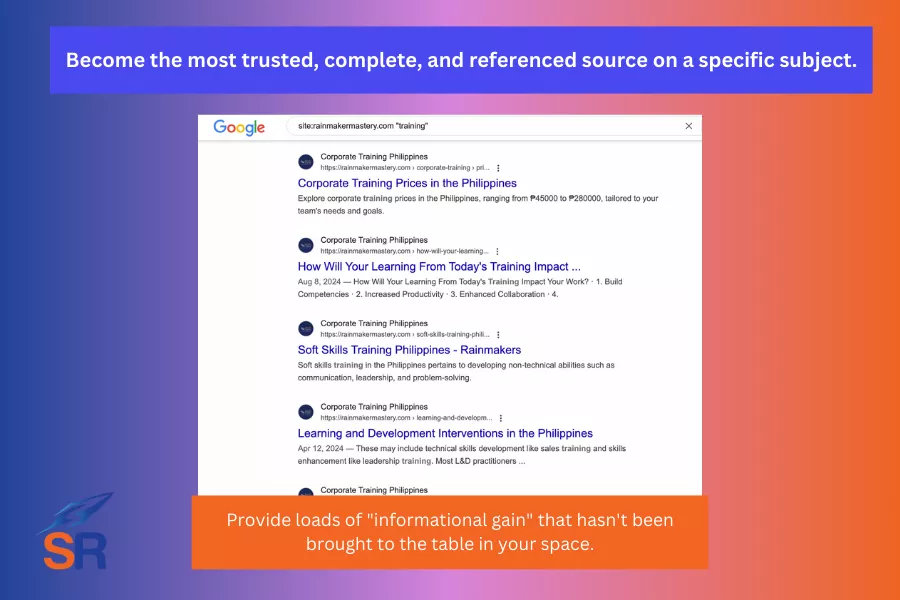
Here's how to build topical authority and attract backlinks your competitors can't replicate:
Choose a specific, business-aligned topic.
Pick one area where your product or service is highly relevant and where your team has deep insight or real experience to provide loads of "informational gain" that hasn't been brought to the table.
The level of specificity you get will make your content more valuable to a defined audience and more link-worthy in relevant articles and roundups.
Build out subtopics that cover the topic thoroughly.
To become authoritative, your site should answer everything someone might ask within the space (a battle of high-quality "content volume").
When a journalist or publisher looks for expert-level information, your site will have it already written and easy to link to. The idea is that your competitors may have 1 to 2 posts on the topic, but you'll have 15+ highly targeted pages that connect and support each other.
Structure it as a topic cluster.
I shared earlier about organizing your content into a hub-and-spoke model. Cross-links between pages so users and search engines can easily navigate your expertise. Potential linkers can quickly see the depth of your coverage, making it more likely they'll link to you rather than a thin, one-off post from someone else.
Add unique value that others can't copy.
This is the step that locks in your backlinks. Include content elements based on your own data, tools, experience, or perspective (as I've shared in the integrated linkable assets section).
These aren't generic tips; they are assets only you can offer. So, even if your competitor writes a similar post, they won't have your exact angle or insights, making your content the preferred link target.
6. Value-First Outreach
Most link-building outreach fails because it's one-sided (most of the time). Value-first outreach flips that, offering something helpful first ("reciprocity effect").
Website owners, bloggers, and journalists receive dozens of link requests weekly. To stand out, your email outreach needs to answer one question: "What's in it for them?"
Value-first outreach earns links by earning trust first, and here are a couple of ways to test in your email outreach campaigns:
- Link swaps—if you manage content for multiple clients or partners, offer a relevant link in return, but no direct change. This method helps you get exposure and stay within the conservative way of doing link building by using indirect or triangular swaps (not one-to-one link exchanges).
- Improve their content with helpful additions—offer insight, data, or clarification to make their existing content more comprehensive. Do the work upfront to make it easy for them to say yes.
- Share or mention their content first (scale it for priority link targets). If you already like their work, mention it in your content before asking for a link, giving them exposure and SEO value upfront. Then, use that goodwill in your outreach.
Value-first outreach works best when you think like a collaborator, not a solicitor.
7. Get Links From Prospect Business Sites (Not Just Industry Blogs)
When building the right types of backlinks, most outreach efforts focus on the usual: industry blogs, roundup sites, and content-focused publications. There's nothing wrong with that unless you're getting from sites with no significant and relevant traffic. However, there's a high-value group to target for links that, more often than not, are overlooked. These are business websites.
Business websites are seen as legitimate by both users and search engines, as they have real-world operations, band equity, existing links from vendors, partners, and local institutions, and minimal outbound link spam.
Getting links from these types of domains carries more weight in link value and is often more challenging for competitors to replicate.
For example, if you sell premium workout mats. Instead of pitching fitness blogs, reach out to:
- Gyms or fitness studios that have a "Recommended Equipment" page
- Athletic trainers who list gear they use with clients
- Franchised gym chains that feature supplier shoutouts on their blog
Another example is if you offer eco-friendly packaging, don't just target green blogs. You can reach out to organic food companies that:
- Feature vendors or suppliers they work with
- Highlight sustainability partners in blog posts
- Have "Sustainability in Our Supply Chain" sections on their site
I can give you more examples, but the principles remain the same: find more business websites with existing resources or blog sections where you can get contextual backlinks to your site.
8. High Link Value with Strategic Content Distribution
Most content distributed on other websites ("guest posts") is treated as one-off link drops. The contributor writes the content, publishes it, and the backlink goes live. Done.
However, if that's where it ends, you're missing the actual value of external content assets. To build high-value backlinks, you need to shift from simply placing content to distributing content that ranks and drives traffic for you and the publisher.
It's a win-win scenario where both parties enjoy the benefits of high-utility content (the publisher gets more traffic while bringing this traffic to the one contributing the content). That's where strategic content distribution comes in.
Strategic content distribution means creating external content pieces that are designed to rank and crafted to match gaps in your target publisher's SEO strategy.
So, instead of just writing a random topic, you write:
- On a topic (or keyword) that's highly relevant to your target customers
- That fits well the publisher's niche
- That's currently missing from their blog or resources section
- That attracts search traffic over time, and they aren't tapping into it yet.
Instead of a mere guest post, you create content that significantly has an impact on your website, given that links:
- Sit on a page that ranks, not buried archive post
- The blog post continues getting traffic over time, sending indirect SEO and brand signals
- Content earns secondary links when others reference the post
- You're seen as someone who improves the site, not just using it for plain reasons.
Here's how to distribute content strategically:
Find the right publishers.
Look for websites that have decent domain authority (e.g. Ahrefs DR30+), regularly publish new content, rank for keywords related to your niche, and accept contributions or have a blog that could benefit from SEO support.
You can use tools like Ahrefs, or SEMRush to assess traffic and ranking potential.
Identify content and traffic gaps on their blog.
Before pitching, do a quick content gap analysis by asking what keywords and topics they are not ranking for and are missing entirely from their blog. Are there blog posts ranking on page 2 that you can help improve or refresh?
To spot thin content, you can use advanced search operators (site: domain[dot]com "topic) or tools like Clearscope or SurferSEO.
Choose topics with the potential to get traffic or with steady search volume.
Target long-tail keywords with lower keyword difficulty (KD), a monthly search volume of at least 100 to 1,000, and that have a clear connection to your niche or target audience.
These terms are easier to rank for and can help deliver long-term traffic to the publisher.
Pitch content that helps them, not just you.
Craft your pitch around how the article can benefit their readers and increase traffic potential.
A sample addition to your outreach pitch would be:
"I noticed your blog doesn't currently cover [topic], which has consistent search volume and ties closely to your audience. I'd love to write a well-structured piece on that, including a few unique insights from our team."
"I'll optimize the post to rank for [keyword]—and link to your internal content where relevant, to strengthen your rankings."
You're positioning yourself as a content partner looking for a more long-term role in content distribution, not a self-serving contributor only asking for links.
Need link building? See our link building services and schedule your free strategy call.
The 5 UK's Best Link Building Services in 2025 [Honest Review]
Link building services can be a huge asset to your brand's overall SEO campaign.
With an agency specializing in link building, you can reap the benefits of pushing your webpages higher in Google SERPs, build your brand authority, and make your offer (products/services) a go-to solution in your industry.
In this guide, I'll explore the five best link building agencies and provide tips for finding the UK's best link building services for your business.
1. SharpRocket
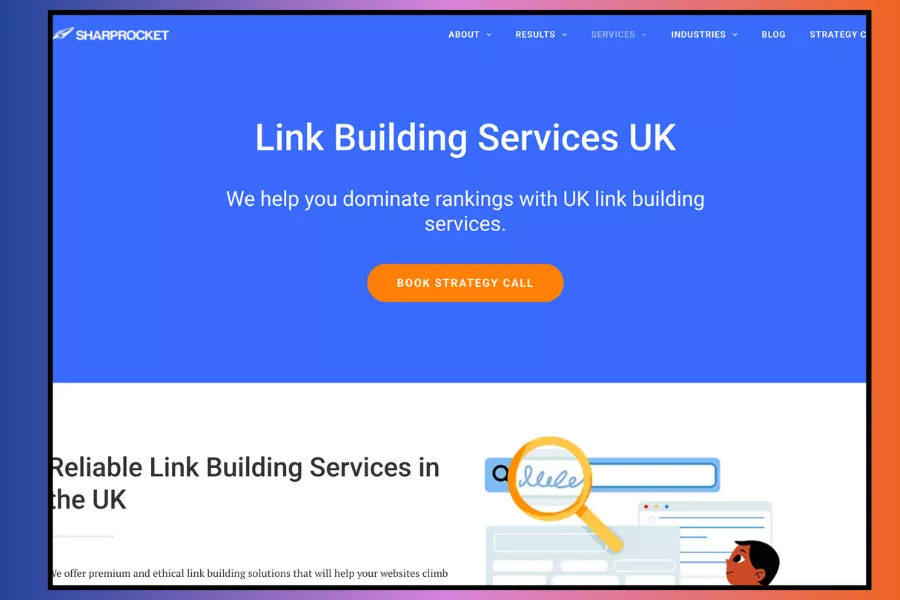
Best for: Agencies, SaaS, eCommerce, and Enterprise Brands
Headquartered in: 100% remote, with headquarters in Manila, Philippines (serving UK clients)
Industries: e-commerce, B2C, B2B, and SaaS
Strengths: Keyword-driven content to drive rankings, increase passive links, and improve organic traffic
Recognizable clients: Credible, Shopify, and Eatigo
With over 10 years of experience, SharpRocket is the leader in acquiring backlinks that will help landing pages rank for their individual commercial keywords and drive organic traffic to the business.
Our global link building agency is known for its high-quality, white-hat backlinks, which help brands increase their organic search presence. Their manual vetting and outreach process ensures that all acquired links come from authoritative, industry-relevant websites. This makes them a trusted partner for businesses looking to scale their SEO through link building.
SharpRocket focuses on content-driven link acquisition, a method for helping brands earn natural, high-quality links through niche edits, guest posts, digital PR, and resource page link building. Their emphasis on customized outreach campaigns builds trust with clients, as each link placed aligns with strict link metrics and the client's SEO goals.
With enterprise link building at our core, our link building services drive rankings, revenue, and brand recognition. We're proven to deliver, with over 15,000+ links and our 10+ years of experience for clients like Keypath, Zenbusines, and Fiddlershop— just check out our client case studies to see for yourself.
2. Search Intelligence
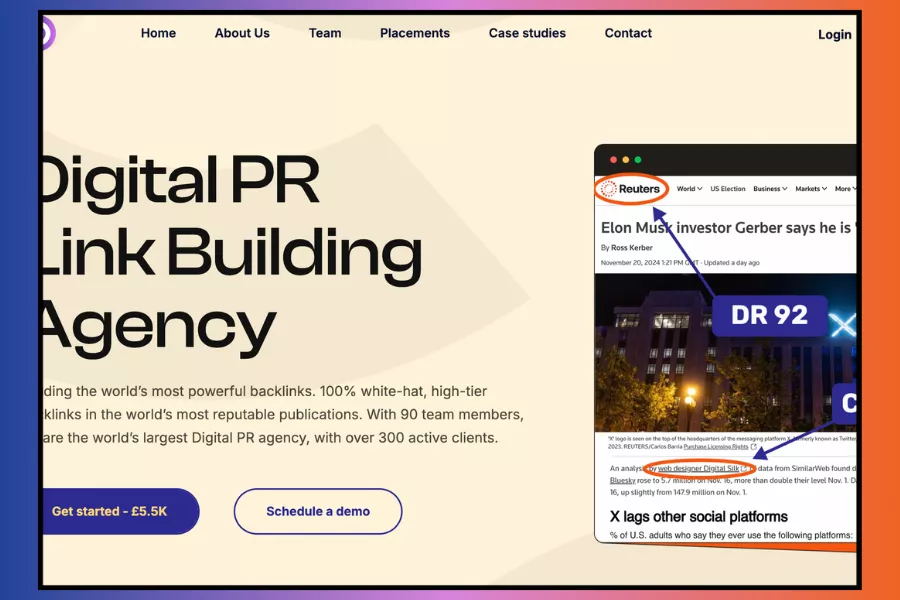
Best for: In-house Teams
Headquartered in: Oxfordshire, England
Industries: Finance, SaaS, Tech, and Legal
Strengths: Reactive PR, Data-driven Campaign, Expert Commentary
Recognizable clients: Ahrefs, Bulk, VPNOverview
Search Intelligence is a leading digital PR and link building agency that specializes in earning high-authority backlinks from top-tier publications through data-driven PR campaigns. Their expertise lies in crafting newsworthy content that attracts organic media coverage, securing backlinks from sites like BBC, Forbes, The Guardian, and The Independent.
Search Intelligence's proven digital PR strategies make them a top choice for brands seeking high-authority, scalable link building solutions that drive both SEO growth and brand visibility. Their focus on data-backed storytelling ensures that clients gain credible, organic media placements that significantly impact search rankings.
3. Bulldog Digital Media
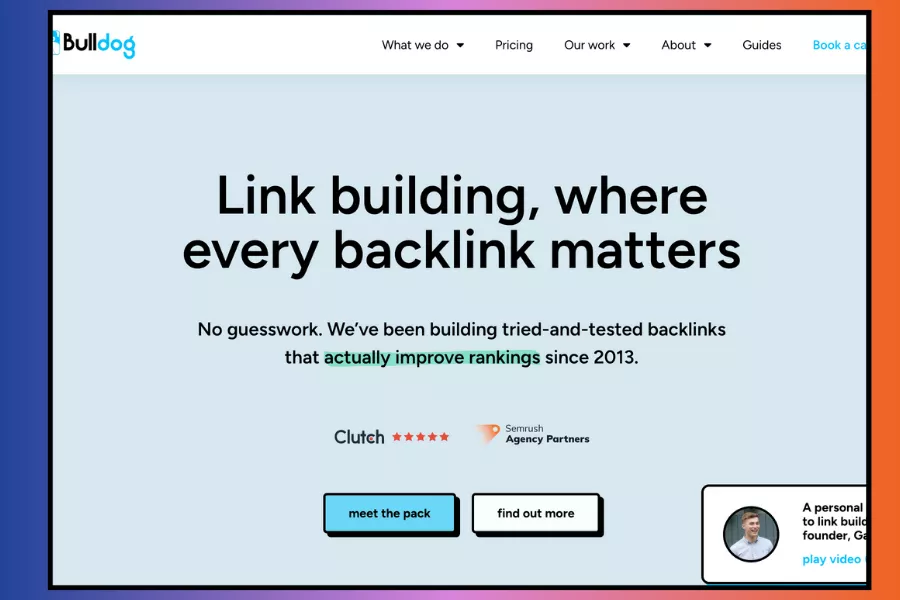
Best for: eCommerce
Headquartered in: London, UK
Industries: Retail and eCommerce
Strengths: Press release creation, Targeted PR outreach, and Journalist request for monitoring
Recognizable clients: La Redoute, Funky Pigeon, Carpetright
Bulldog Digital Media offers a unique, risk-free digital PR service with a pay-per-placement pricing model, ensuring clients only pay when placements go live. Clients set their monthly budget, and Bulldog's dedicated team executes PR strategies without upfront fees. Their flexible approach allows clients to adjust budgets as needed.
The agency's process includes monthly brainstorming sessions to develop PR story ideas, crafting press releases, monitoring expert comment opportunities, and building relationships with journalists and bloggers. This strategy has led to features in over 300 publications in the last year, enhancing brand visibility and authority.
Their commitment to transparency, flexibility, and results-driven strategies makes Bulldog Digital Media a trusted partner for brands aiming to enhance their digital presence through strategic PR initiatives.
4. UK Linkology
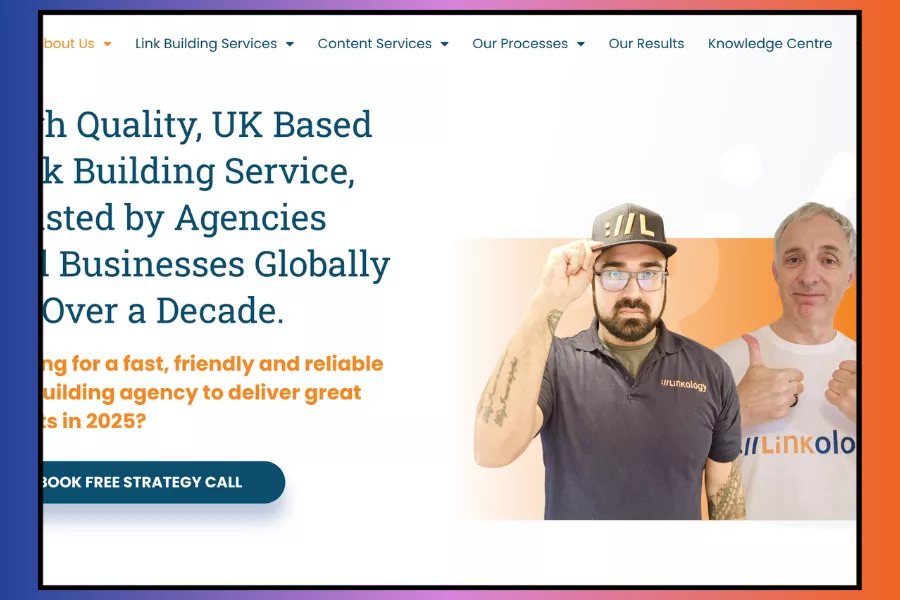
Best for: Local and brick-and-mortar businesses
Headquartered in: Derby, UK
Industries: Various sectors, including gambling and iGaming
Strengths: M-Flux V2 site assessment, extensive publisher database and gambling link building capability
Recognizable clients: N/A
UK Linkology is a UK-based link building agency specializing in delivering high-quality, contextually relevant backlinks to enhance website authority and search engine rankings. Their proprietary M-Flux V2 formula assesses websites using five SEO metrics and a 33-point manual site check, ensuring that only reputable sites are selected for link placements.
The agency boasts a vetted publisher database of over 61,000 sites, built since 2010, allowing them to cater to both English-speaking and international markets. They offer various services, including custom link building, white-label solutions for agencies, international link building, and specialized services for industries like gambling and iGaming.
5. Click Intelligence
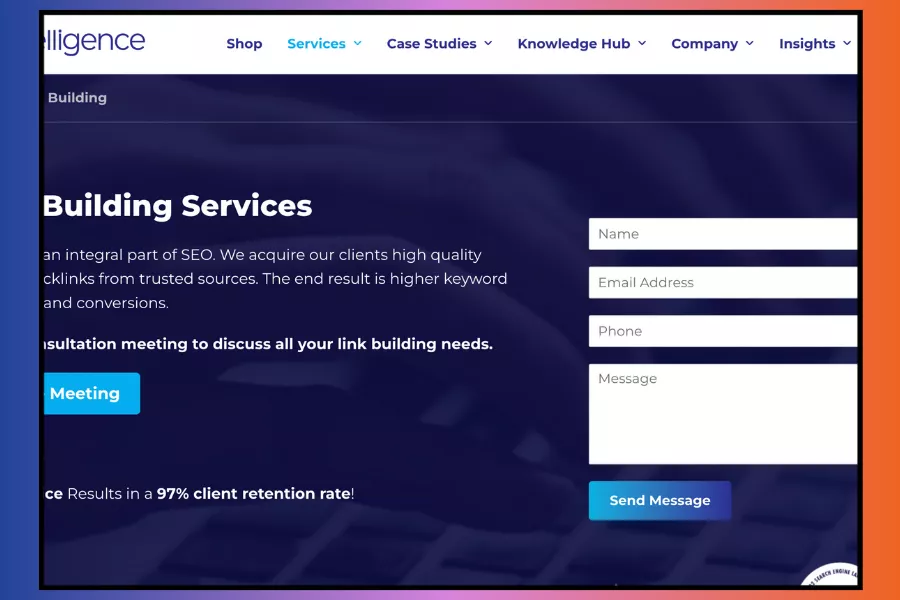
Best for: Digital marketing and SEO agencies
Headquartered in: London, UK
Industries: SaaS, iGaming, Travel
Strengths: White label solutions
Recognizable clients: eBay, AX Paris, Gumtree, Holiday Inn
Click Intelligence also provides specialized link building services tailored to specific industries. Their iGaming Link Building strategy is designed for the competitive gambling sector, improving search visibility and driving business growth.
They also excel in resource link building, positioning clients as industry experts by securing backlinks from existing listicles through targeted campaigns.
Tips for Finding the UK's Best Link Building Services
Interested in implementing a link building strategy but not sure where to start? Read more for tips on finding the best link building agencies and services.
Prioritize Agencies with a Proven Track Record
Look for agencies with a history of delivering high-quality backlinks for clients. Check their performance in case studies, online reviews, and industry reputation.
A reliable link building agency should be transparent about its strategies and provide you with examples of its successful link placements. By looking at their live links from disclosed clients, you can easily assess if they are worth investing in.
Avoid agencies that promise quick results or use black hat techniques, as these can lead to penalties. Always verify the credibility of their past work before committing.
For example, SharpRocket has been delivering thousands of quality links to clients since 2015. Its decade worth of experience and expertise can attest to the results it provided for past and current clients. Their proof of work with Shopify, Fiddlershop, and many other esteemed clients tells you how prolific they are in enterprise-level and eCommerce link building campaigns.
Evaluate Their Link Building Strategies
Not all link building strategies deliver long-term results. Some agencies use link placement shortcuts that only harm rankings instead of improving them.
The best agencies focus on tried-and-true, white-hat techniques, such as guest posting, link insertions, digital PR, and product-led link building. These techniques require manual outreach to secure placements on relevant and trusted sites rather than relying on automated link schemes.
You should also look for agencies that provide detailed reports outlining link sources and the quality of acquired backlinks (based on agreed-upon metrics).
Assess Industry Experience and Specialization
Some agencies specialize in specific industries, such as finance, SaaS, legal, or e-commerce, while others offer generalized services. If you operate on one vertical with one or multiple businesses, you can look for an agency that is already familiar with your niche so you can get more relevant and impactful backlinks.
Different industries have nuances in markets and methods, so having an agency with deep expertise in your market can help you gain more advantages for your link acquisition campaigns.
From a content marketing perspective, it could help you develop more targeted content that aligns with your audience, given that there's a higher level of familiarity with the market and the audience the agency is writing for.
Verify the Quality of Their Link Sources
You should consider agencies that can secure links from relevant, editorially controlled sites with strong domain authority (Ahrefs' DR) and organic traffic.
These contextual backlinks pass more value than other types of links. Avoid agencies that place links on low-quality directories, private blog networks (PBNs), or spammy sites.
Look for Transparent Reporting and Communication
The best link building services provide clear, detailed reports showing their built links, along with metrics such as Ahrefs DR, organic traffic (data from SEMRush traffic), and anchor text usage.
With them providing you with regular updates, you can keep track of campaign progress and effectiveness, helping you decide whether to ramp up more links to achieve better results or dedicate other links to your other businesses.
Avoid agencies that fail to disclose their link sources or use vague reporting methods.
You could glimpse the agency's willingness to serve through your initial interaction after you submit an inquiry through their contact forms. The best link building agencies are responsive to inquiries and ones that provide realistic timelines and set clear expectations.
Consider Pricing and Value for Money
Pricing varies significantly among link building agencies, depending on link quality, strategy, and industry demand. Link building comes with investment, so make an allowance in your budget when seeking the right fit for your link building needs.
Be wary of cheap services that offer bulk link packages. These often use low-quality sites or automated tactics.
On the other hand, expensive services should justify their costs with premium placements and overall legwork (or inclusions) in their services. Request a breakdown of costs to ensure you’re getting real value for your investment.
By following these guidelines, you can identify a reputable UK link building service that supports the sustainable growth of your SEO team (either you're an in-house SEO or agency).
FAQs
You may be thinking a lot about finding the right link building provider right now, so here are some frequently asked questions about link building services.
What Do Link Building Agencies Do?
Link building services help businesses improve their search engine rankings by getting more relevant, quality backlinks. These services use various strategies to build organic, contextual links that enhance a website’s authority and credibility in Google's search results.
They execute campaigns and strategies to improve the site's crawl rate, search potential in rankings, and potential assisted conversions through:
- Manual outreach – Securing backlinks through personalized communication with website owners and publishers.
- Guest posting – Publishing high-quality distributed content on authoritative websites with embedded backlinks.
- Digital PR – Earning links through media outreach, data-driven campaigns, and newsworthy content.
- Niche edits – Placing contextual links within existing high-authority content.
- Resource link building – Getting links from resource pages that reference useful industry content.
Why Is Link Building Important?
Link building is a crucial aspect of SEO strategy, as search engines use and highly consider backlinks as a ranking factor. High-quality backlinks signal trust and authority, leading to better organic rankings and increased website traffic. Effective link building can also:
- Strengthen brand visibility and industry credibility.
- Drive referral traffic from authoritative sources.
- Improve search rankings and domain authority over time.
- Support long-term organic growth without relying solely on paid ads.
What Is the Average Cost of Link Building Services?
The cost of link building varies based on factors like link quality, outreach strategy, and industry competitiveness. Pricing typically falls within these ranges:
- Blogger outreach campaigns – $250–$1,000 per link
- Digital PR link building – $5,000–$15,000 per month
- Guest posting services – $100–$700 per post, depending on site authority
- White-label link building – Custom pricing for agencies outsourcing services
At SharpRocket, link building services are tailored to deliver topically-relevant, high-quality backlinks to move the websites' most important pages higher on Google's SERPs. Their pricing is structured to ensure that clients receive guaranteed, authoritative, niche-relevant links that drive real SEO value.
Fuel SEO Growth with Link Building
There are many link building agencies and services to choose from, but it's up to you and your team to find the one that best fits your brand's SEO goals and objectives. At SharpRocket, our team of link building specialists and strategists can get high-quality backlinks that fit several needs— we have almost 15,000+ backlinks secured that generated traffic revenue for our clients to actually prove it.
Looking to take your SEO to the next level with link building efforts? Check out our link building services and get a free link building roadmap.
Outsource Link Building - Needs, Benefits, and How-to [Templates Included]
If you’re running an SEO agency with growing link building needs, you’re facing some crucial decisions. Taking on more SEO clients is vital to growth, but ramping up more backlinks to improve clients’ website rankings comes with major financial and operational responsibilities.
Outsourcing link building is a strategic decision and process that allows businesses and SEO agencies (like you) to scale, allocate resources effectively, and focus on core operations.
With growing demands, checklists, and to-dos in every SEO campaign, most companies lack the in-house expertise, time, or tools to execute a successful link building campaign.
The central question we’ve always been asked is, “When and when not to outsource link building”? Let’s answer that right here.
When and When Not to Outsource Link Building?
You outsource link building when:
- Your team lacks specialized knowledge in link prospecting, link qualification, outreach, and producing both product-led and content-led assets.
- You need to scale link-building efforts without hiring and training an in-house team (or dedicating some SEO specialists to link acquisition).
- You want to focus on growing your business (client acquisition, service delivery, client satisfaction, etc..) while a link-building agency handles the backlinks part.
It is not ideal to outsource link building when:
- You haven’t built your website's initial and proper SEO foundation (technical SEO, on-page SEO, site architecture, content, etc.). You can’t rely solely on link building to rank your clients’ websites.
- You prefer a lower cost per link with full control over link sources and outreach strategies.
- You’re serving $1,500/month client retainers with fewer budgets allotted for link building (this kind of budget constraint makes outsourcing impractical).
Benefits and Downsides of Outsourcing Link Building
If you’re thinking of outsourcing link building, consider both its benefits and downsides.
Link building is worthwhile, whether in-house or outsourced to a trusted link-building agency, if you balance them and discern the right option based on your current situation and context.
Benefits of Outsourcing Link Building
Expertise, Experience, and Efficiency
This is the primary reason why SEO agencies and businesses want to outsource link-building work to someone else. More often than not, if the in-house team doesn’t have the built-in processes and experience required to acquire backlinks for clients—it consumes more time than they would think of if they did link-building in-house.
Speaking of experience, observing nuances in link building for each niche market takes months and years. If you’re an SEO agency, building links for vet clinics isn’t as easy as building links for a fintech website. The challenges within each market require expertise to overcome even just the initial roadblocks.
Another example is doing competitor backlink analysis. An SEO beginner in link building would have focused more on link metrics when analyzing competitors’ links.
However, that approach is just an initial activity for a link-building expert. He or she delves deeply into the types of links competitors built and assesses probable reasons for linking—which is more advanced. To reach that certain level of mastery, several hours of scanning backlink reports are required (and that’s what makes them “experts” in the process).
Scalability
When discussing scalability, marketers only focus on the number of links. Of course, link building agencies can build more links in less time than an in-house team.
However, that’s only one part of scalability. Link-building agencies' biggest advantage is expanding linkable markets by conducting more outreach campaigns, giving the client’s brand more reach it deserves.
Given their years in the SEO game, they have lists of tens of thousands of webmasters and journalists. With relationships they’ve built, it’s easier for them to nudge link requests, get more positive responses for expert commentaries in digital PR, or have more straightforward link inclusion on a resource page.
Topping it off, as you scale link-building projects with an agency, you also get cost efficiency when adding more projects. That’s where discounts (or more links in exchange for referrals come in).
In general, relationships with link-building agencies don’t have to be stiff—it can be dynamic and mutually benefit both parties.
Preference For Link Types
Outsourcing link building allows you to choose specific link types you want to integrate into your site’s backlink profile.
Different agencies have several packages and options according to the types of links that you’re getting as a client. From niche edits to guest posting links, go way up to top-tier publications backlinks using digital PR.
Pro Insight: This link type preference is more strategic and beneficial than choosing links based on specific Ahrefs’ Domain Ratings (e.g., DR30 to 50, DR50 to 90). It’s now easy to purchase links from generic link vendors, so the best approach is to get backlinks from agencies that consider link types.
Downsides of Outsourcing Link Building
Outsourcing link building also has its fair share of downsides that businesses must be fully aware of.
Higher Costs
This is the first on the list, and agencies and brands must consider their budget before onboarding a new link-building partner.
For instance, if you’re an early-stage startup and still testing product-market fit (in other words, you haven’t had enough recurring customers to sustain your business), outsourcing link building (even outsourcing SEO at large) is not the best move.
However, as you soon get more funding to test and invest in a solid marketing channel, you can now outsource SEO. This is based on my observations working with several startups (both funded and bootstrapped).
Quality Control
You’ll only see the quality of links at the time of reporting, which means you don’t have full control over the outcome.
Pro Tip: Start with a trial version or 3-month link-building project before investing long-term (more than a year) with your link-building agency. You have to test and see the actual live links they’ve acquired so you can rest assured of the quality before throwing more bucks into your investment.
Dependency on External Partners
This isn’t very relevant to in-house SEO teams. But for SEO agencies that provide regular client reports, it’s important to have a good monitoring process with your preferred link-building vendor so you can sustainably see the outcome and, therefore, help you deliver regular backlink reports for clients.
This is to avoid any delays in backlink deliverables and to adjust strategies based on actual performance and your SEO recommendations with your clients.
For example, if you change a strategy, let’s say you want to build backlinks to a new landing page (product/service feature), you could quickly and flexibly do it only if you have a good link building partner who’s willing to change the strategy as the need arises.
That dependency on external partners is crucial when outsourcing link building projects.
Preparing Your Website for Link Building
As I mentioned earlier, your website must be optimized well to maximize the impact of backlinks.
This approach ensures you strengthen your SEO campaign and avoid pointing backlinks to weak pages (or pages that don’t convert). It’s best to start linking your initial set of links to pages that matter most to you in terms of achieving search traffic (and to your client, in terms of achieving their business goals and revenue).
Here are a couple of tips to prepare your website for link building:
- Technical SEO - improve crawlability and performance by boosting page load times, cleaning up code, etc.
- On-page SEO - optimize each web page’s content and HTML, including the target keyword in strategic places (title tags, header text, images, and more).
- Content Creation: Develop and publish content assets relevant to your audience (e.g., landing page copy, blog articles, infographics, resource guides, etc.).
The reality is building backlinks alone is not enough to guarantee SEO success.
Take the first actions on the listed items earlier to get Google to crawl, index, and receive your pages well, making them deserving of ranking in Google’s SERPs for their target keywords.
Then the content promotion part, including link building—which you can outsource if you prefer—will have more impact on the overall SEO performance of your website.
Budgeting for Link Building
A critical part of your decision to outsource link building is your budget.
Generally, you have two options: doing link development in-house or outsourcing it to a link-building agency.
Both come with a cost.
That’s why we created an in-house VS agency calculator to help you determine the actual total costs and cost per link for each option. This will help you decide which one is more cost-efficient and worth your investment for your website in the long run.
Choosing the Right Link-Building Partner
Once you decide to outsource link-building to an agency, choose the right link-building partner.
You must find a link-building agency that provides individualized care and doesn’t treat your clients' websites like statistics. Pick the wrong partner, and you’ll end up damaging your clients’ link profiles, and your clients will think you’re the one messing it up.
Now, there are several ways to source link-building agencies.
The best one is asking for recommendations from your SEO networks. Those you’ve known over the years and built trust in the quality of work are the ones you should highly consider.
Given that you’re already familiar with the caliber of their service, you’re likely to end up with another good service from them for your current SEO campaign.
Be wary of link-building agencies, which you only see in any ads today. If you come across them, verify through their website and check their current and past clients and case studies - this would show if they can be trusted for results.
Finally, once you have a list from different sources, it’s time to have a set of criteria to choose the best outsourced link-building partner.
How to Outsource Link Building?
Needless to say, not all link-building agencies are equal. Having a set of criteria to identify the best fit can help you increase your confidence in making the right decision.
The number one mistake I’ve seen with agencies and businesses outsourcing link building is that they don’t have a set of criteria to base their decisions on, leading them mostly in making the wrong decision.
To simplify things, I’ve created a spreadsheet to help you choose the best link-building agency.
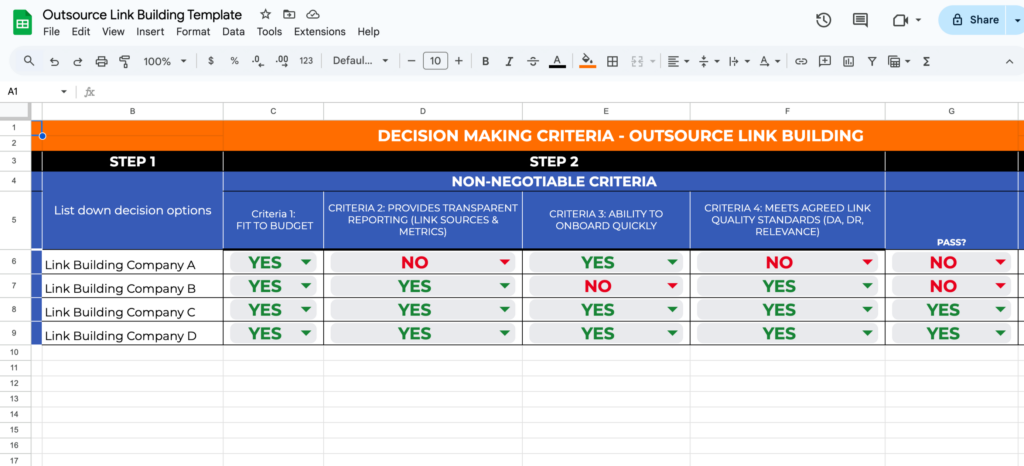
Here’s a step-by-step process for filling out the spreadsheet (which is also included in the “Instructions Tab”).
Step 1: Define Your Criteria
List down negotiable and non-negotiable criteria for your decision-making process in outsourcing link building. You can use the ECTEA model (Effectiveness, Cost, Time, Effort, Acceptance) to guide your criterion.
Step 2: Set Up the Decision-Making Analysis Sheet
In the Decision-Making tab, paste all your negotiable and non-negotiable criteria into separate columns.
Adjust columns and rows based on the number of criteria you have.
Step 3: Evaluate Link Building Agencies
Evaluate each link building agency based on your given criteria (both non-negotiable and negotiable).
For non-negotiable criteria, mark "Yes" or "No" for each link-building agency.
Proceed only with agencies that meet all non-negotiable criteria (i.e., all "Yes" responses).
Step 4: Rank Agencies Based on Negotiable Criteria
- For each negotiable criterion, mark "Yes" or "No" for every agency.
- Assign a score from 1 to 5 (1 = lowest, 5 = highest) based on how well the agency meets the negotiable criteria.
Step 5: Calculate Weighted Ratings & Make The Best Decision
- Compute the weighted rating by summing up the scores for each agency.
- Consider the link-building agency with the highest overall rating.
This decision-making analysis template allows you to make a rational, objective decision based on your criteria. You can do it yourself or best with the team of stakeholders and decision-makers in your team in outsourcing link building.
Evaluating Link Building ROI
Link-building ROI warrants a new guide, which I’ll share soon.
But in summary, if you want to see the value of your efforts, you should measure your link-building investment.
Here are a couple of things our clients looked at (and highly consider) with their investment in our link-building agency:
Page-Level and Category-Level Performance: Measure link impact on individual pages of your target links, in terms of increase in rankings, organic traffic, and page’s traffic value. It’s easy to track this using Ahrefs or other link intelligence tools.
ROI From Target Pages: If you select pages to build links to, you can track the return on investment you get from links that you outsource.
First, determine your conversion rate, average order value, and lifetime customer value for that specific product/service. Set this benchmark based on the current conversion for that page from organic search - you can see it on Google Analytics. These value items will be your baseline in checking if there’s ROI from links.
Share of Voice: Assess how much visibility your brand gains relative to competitors. SEMRush allows you to quickly see the share of voice—based on the competitors you input in the dashboard.
Types of Link Building Services
Agencies have different link-building models to choose from:
Managed Link Building Plans
Agencies handle everything from strategy to execution, involving link-building strategy, prospecting, outreach, and reporting. This is a done-for-you service that takes your hands off everything related to link building.
Pay-Per-Link Pricing:
This is arguably the best type of link-building service model. Given that you’ll only be paying for links you receive and have been reported by the agency, you only pay for actual results - not for monthly retainers with no guarantees of the number of links to be delivered.
At SharpRocket, we operate on this pay-per-link pricing model. We want to serve our clients at the highest level and earn everything they pay us.
If you need a few links to boost the rankings of your key pages or are looking for a reliable link-building partner to scale your link-building projects, contact us today for a discovery and strategy call.
